Fantasy Books
Houses of Ill Repute: Witchcraft for Wayward Girls by Grady Hendrix and Starling House by Alix E. Harrow
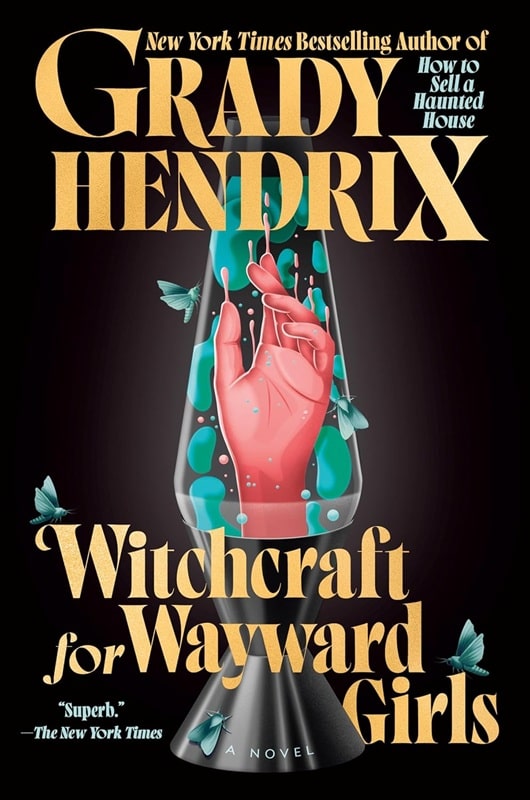
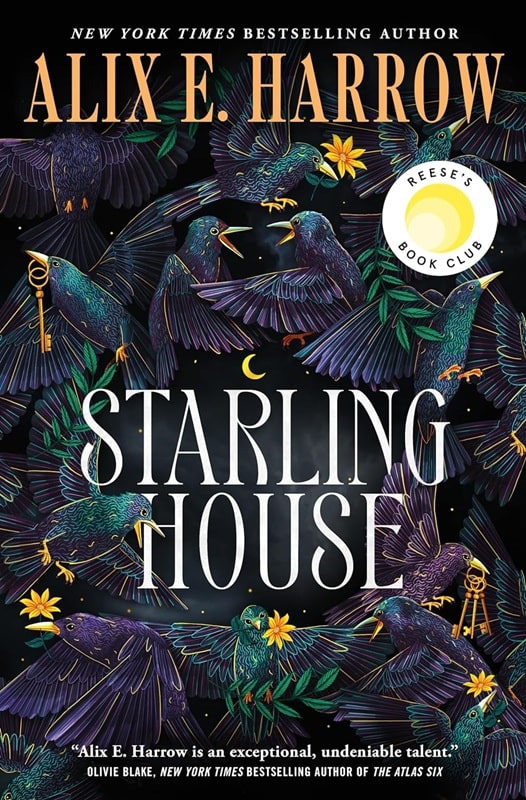
Witchcraft for Wayward Girls by Grady Hendrix (Berkley, January 14, 2025) and
Starling House by Alix E. Harrow (Tor Books, October 3, 2023). Covers: uncredited, Micaela Alcaino
No, not that kind of house of ill repute (though I confess I thought the semi-salacious implication of the headline might get some of you to read a bit further, though of course not you who are reading this now, just all those others). Rather the gothic trope of the creepy house, the mansion where ancestral secrets lie, where bad things happen. From The House of Seven Gables to The Fall of the House of Usher to Wuthering Heights to more contemporary (all the more so because they actually existed) houses of horror such as Colson Whitehead’s Nickel Academy and Tananarive Due’s Dozier School of Boys, these are places that present a facade of safety, but are far from it.
That’s the kind of house found in Grady Hendrix’s Witchcraft for Wayward Girls. Don’t be put off by the middle school YA sounding title. Homes for “wayward girls” actually existed in mid-20th century Florida. It was where unmarried pregnant teenagers were sent to have their babies, give them up for adoption, and then return to “normal” life with their and their family’s “reputations” intact.
The adolescent pregnant girls, literally abandoned by her parents for committing a sexual and “moral” offense (to my knowledge, there were no homes for boys who fathered out-of-wedlock babies and put the mothers in this position) became subject to “we know what’s best for you” treatment and holier-than-thou attitudes. In all too many cases, preserving the girl’s good name and future marriageability provided cover for the lucrative practice of selling newborns to adoptive parents on top of charging parents for room and board and, above all, discretion.
As Hendrix points out in an afterword,
Most homes confined their girls to the property… [some] forbade the use of makeup, censored the girls’ mail, charged them extra for dessert, and refused to allow them any communication with the outside world…Girls who changed their minds about adoption and tried to keep their babies would be subject to a tactic a tactic informally known as “The Bill.” At the last minute, a caseworker or staff member would inform the girl that her accumulated charges had to be paid before she could go home with their child. The Bill was usually so high that a girl had no hope of paying and so, whether she wanted to or not, she had to allow her baby to be put up for adoption.
This kind of house already earns its horrific bona fides without need of supernatural intervention (indeed, Hendrix says the first two drafts didn’t contain any fantastical elements). Adding witchcraft, however, layers a metaphor for women’s empowerment, albeit one that carries a price, that is closely associated in folklore with childbirth. As Hendrix notes,
There’s a popular [though discredited] myth that the Catholic Church targeted midwives as witches… In fairy tales, witches are constantly eating or stealing babies. In the fevered popular imagination, witches crown their black sabbaths with a child sacrifice.
The story centers on Fern (all the girls are given an arbitrary plant-based pseudonym during their stays, ostensibly to preserve privacy, but actually to depersonalize them), a 15 year old in effect kidnapped by her father to endure her pregnancy at the Wellwood House in St. Augustine, Florida in the summer of 1970. Her situation is not, needless to say, a happy one.
No one would write, no one would call, no one outside this house even knew where she was, except her dad, and he hated her. She never felt more alone. She would do whatever they wanted her to say, eat whatever they told he to ear, just so long as they let her of back to the way thing were before.
The smart-assed (if ultimately superficial) hippie-styled resistance of a fellow wayward girl provides some hope of eventual escape from the home’s adult “benefactors.” But it is a bookmobile librarian who hands Fern a tome entitled How to be a Groovy Witch that leads to the invocation of witchcraft to avenge mistreatment.
Unfortunately, to paraphrase Peter Parker, with great power comes unexpected consequences and questions of responsibility. And just as it’s one thing to proclaim hippie slogans and quite another to actually adhere to them in the real world, practicing witchcraft also comes with significant moral compromises. Which Fern must balance against the familial and social stigma of unwed pregnancy, of being forced to give birth and then relinquish her child. As once of the wayward girls now an adult and long after giving up her baby puts it:
There’s a part of me that’ll always be seventeen. A part of me that’ll be seventeen forever, locked away in that Home, cut off from the world.
That’s a house you can run away from, but never escape.
Locked away and cut off from the world is also the predicament in Alix E. Harrow’s The Starling House. Instead of the proverbial madwoman in the attic, it’s a male recluse in the titular creepy home containing disturbing secrets. Another kind of forced habitation is the stifling town, the ironically named Eden, Kentucky, modeled somewhat after the equally ironically named and actual Paradise, Kentucky immortalized in the John Prine song about a family-owned coal company that exploits the land and resident workers. It’s a place Kentucky native Harrow knows as “a place of very mixed experiences that I love very, very, very much, and which has just an incredible violence and terror to it.”
Our heroine, Opal, is a social malcontent and for the most part first-person narrator (there are also point of view shifts and even footnotes and a bibliography!), a high school dropout working a dead-end job in a dead end town. Orphaned following her mother’s death in a car crash, she is trying to save up money to send younger brother Jasper to a private school and get a better life out of Eden. But kind of hard to do on a Tractor Supply cashier’s salary and some petty larceny.
Walking to work, Opal finds herself strangely (of course) drawn to the ancestral home of the Starling family, one of whom wrote a dark fantasy for children called The Underland (the book’s illustrations appear throughout) and disappeared under, of course, mysterious circumstances. Part of the house’s appeal to Opal is how the shapes on the front gate remind her of the creatures depicted in The Underland.
The gates of Starling House don’t look like much from a distance — just a dense tangle of metal half-eaten by rust and ivy, held shut by a padlock so large it almost feels rude — but up close you can make out individual shapes: clawed feet and legs with too many joints, scaled backs and mouths full of teeth, heads with empty holes for eyes.
Opal feels compelled to look inside the old neglected house, managing to convince the current Warden, Arthur Starling, despite his initial misgivings, to hire her as a housekeeper. Opal soon discovers a special strange connection to the equally strange house. And to Arthur.
Sinister forces soon intercede, however. The aptly named Gravely Power company wants to acquire the Starling House property by means fair or foul. And then there are supernatural entities literally right out of The Underling. All of which jeopardize Opal’s already problematic relationship with Arthur.
The Starling House has rooms for just about everything — Southern gothic horror, classic fairy tale, corporate evil, environmental and class issues, a love story even (it’s not coincidental that Harrow makes a point of mentioning in the Acknowledgement that her mother “read every version of Beauty and the Beast with me”), all wrapped together in a single, ahem, attractive property. It’ll particularly resonate with anyone who grew up in a small town or boring subdivision who tried to run away from the horror of humdrum existence.
David Soyka is one of the founding bloggers at Black Gate. He’s written over 200 articles for us since 2008. His most recent was a review of The Bright Sword by Lev Grossman.
18 Lectures in “Immemorial” Shine A Light | Making Memories For Our Future
Immemorial is a synthesis of reporting, memoir, and essay, reflecting on the design and function…
The post 18 Lectures in “Immemorial” Shine A Light | Making Memories For Our Future appeared first on LitStack.
Spotlight on “Making History” in Paperback by Richard Cohen
Making History is an exploration of who gets to record the world’s history—from Julius Caesar…
The post Spotlight on “Making History” in Paperback by Richard Cohen appeared first on LitStack.
A (Black) Gat in the Hand: Weird Tales Rings in Conan
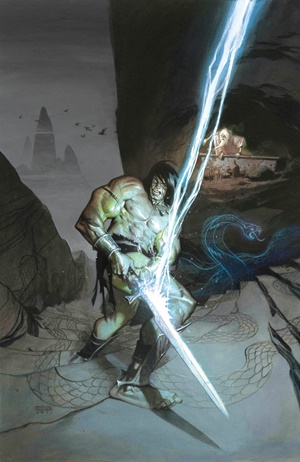 “You’re the second guy I’ve met within hours who seems to think a gat in the hand means a world by the tail.” – Phillip Marlowe in Raymond Chandler’s The Big Sleep
“You’re the second guy I’ve met within hours who seems to think a gat in the hand means a world by the tail.” – Phillip Marlowe in Raymond Chandler’s The Big Sleep
(Gat — Prohibition Era term for a gun. Shortened version of Gatling Gun)
Back in 2018, I started A (Black) Gat in the Hand because I wanted to share my love of hardboiled Pulp. I’ve had some friends join in, and they’ve added some non-hardboiled Pulp, while I’ve expanded my coverage. I’m currently working on my third Kirby O’Donnell essay, and my first on Harold Lamb, which takes us to the Adventure Pulps. And I’m starting another Robert E. Howard Weird Menace post, looking at his occult investigators, Conrad and Kirowan.
One of those stories has a direct link to Conan! A key part of that one is The Ring of Thoth Amon. And if you like the mighty-thewed Cimmerian, you know that ring is integral to the very first Conan tale, “The Phoenix on the Sword.”
Two years before I kicked off my Pulp series under the first title of With A (Black) Gat, I wrote one of the very first essays for Hither Came Conan. Six years ago now, I ruminated on “The Phoenix on the Sword.” I like that story quite a bit. So, we’re bringing that post back for the Summer Pulp series, while I work on the second life of The Ring of Thoth Amon.
I’m pretty sure “Phoenix” was the first Conan story I read. Now, it might have been “The Thing in the Crypt,” in the first Lancer/Ace collection, which I had bought and then stuck on a shelf for at least a decade or two. But I didn’t remember that story when I started going through the Ace books, AFTER exploring Conan via the Del Rey trilogy. So, I think it was “Phoenix.”
The Phoenix on the Sword
It is well known that “The Phoenix on the Sword,” the first story of Conan the Cimmerian, was a rewrite of a previously unsold tale of an earlier Howard character, Kull, an exile from Atlantis.
Howard sold three Kull stories to Weird Tales, appearing in the August and September issues of 1929, and finally, in November of 1930. Howard also wrote nine more tales about the character, which were not published until after his death. So, only 25% of his Kull stories sold. Not exactly a money-maker.
However, “By This Axe I Rule!”, which had failed to sell to Argosy and Adventure, was dusted off to feature a less-philosophical barbarian.
I struggled through the Kull Canon. I definitely prefer Conan, Solomon Kane, and El Borak. The Kull stories seem, to me, to be overly philosophical and full of metaphysical meanderings. “The Mirrors of Tuzun Thune,” which actually appeared in Weird Tales, is one of my least favorite of Howard’s published work. Kull stares in mirrors all day, waxing thoughtful. It’s mind-numbingly dull.
SPOILER ALERT – You absolutely should already have read the original REH story, before reading this essay. Reading on before reading Howard’s “The Phoenix on the Sword” makes no sense at all. You’re definitely gonna ruin the story. END OF SPOILER ALERT.
The heart of “Axe!” and “Phoenix” is the same. A barbarian has taken the kingship of a civilized nation by the sword. He is hailed as a liberator at first, but his status as an outsider and a savage undermines his rule. A coalition of malcontents, led by one Ascalante, plots to assassinate him in his rooms at night: both stories include a banished former noble now outlaw; a useless noble with a faint trace of royal blood in his veins; a dwarf noble with waning influence and declining wealth; an ambitious military commander; and a fool-headed minstrel. That part of the story is all but the same, even to a bribed officer of the guard leading away the royal bodyguard and disappearing forever (smart guy).
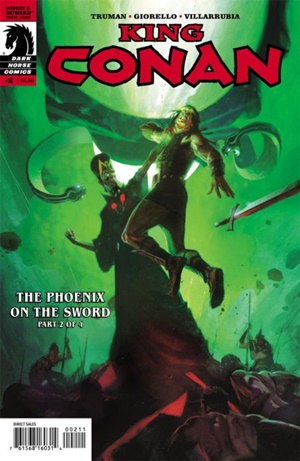 The fight, when the conspirators, with 16 nameless rogues to help, invade the royal bedchamber, is pretty much the same in both stories. Well, to a point…
The fight, when the conspirators, with 16 nameless rogues to help, invade the royal bedchamber, is pretty much the same in both stories. Well, to a point…
Where the “Phoenix” varies is that, in replacing Kull with Conan, Howard makes it a sword and sorcery story. The subplot in “By This Axe I Rule!” involves a young noble, Seno val Dor, who wants to marry Ala, a slave girl. However, such a union is forbidden by Valusian law. And law is inviolate. Even the king is helpless to change it. Seno and Ala cannot wed.
Kull fights off the almost two-dozen invaders, until only Ascalante remains. The rebel has the advantage, until Seno arrives and slays the would-be assassin with a thrown dagger. Ala had overheard the plot and gone to her beloved, who gathered up his men and rushed to the king’s aid.
Kull, wounded and weak, orders the tablet regarding the law of slaves to be brought to him. Once that’s done, he lets his thoughts be known:
“Hear you! I am weary of this business! I am no king but a slave! I am hemmed in by laws, laws, laws! I cannot punish malefactors nor reward my friends because of law – custom – tradition! By Valka, I will be king in fact as well as name!”
He declares that Seno and Ala saved his life, and they may marry. This does not go over well with the traditionalists, as you can well imagine. The king is… unperturbed.
‘”I am the law!” roared Kull, swinging up his axe; it flashed downward and the stone tablet flew into a hundred pieces. The people clenched their hands in horror, waiting dumbly for the sky to fall.’
Thinking outside the box was not exactly encouraged in Valusia.
The speech continues as Kull drives his point home, tossing aside the royal scepter and brandishing the bloody axe. At the end of the story, it’s clear he will rule, enforcing those laws he declares just and discarding those he does not. It certainly seems like the blueprint for an unchallenged despot.
It’s actually a decent enough read and not a bad story.
But for “The Phoenix on the Sword,” Howard completely tosses out the noble-slave love story and the discourse on the suffocating effects of unalterable law. Instead, he brings in the fantastic, making it a sword and sorcery tale.
Now, Conan does wax eloquent on the duties of kingship, just as Kull did. This:
“The trouble with me, Brule – I did not dream far enough. I always visualized merely seizing the throne -I did not look beyond. When King Borna lay dead beneath my feet, and I tore the crown from his gory head, I had reached the ultimate border of my dreams. From there, it has been a maze of illusions and mistakes. I prepared myself to seize the throne – not to hold it.”
Became this:
“I did not dream far enough, Prospero. When King Numedides lay dead at my feet and I tore the crown from his gory head and set it on my own, I had reached the ultimate border of my dreams. I had prepared myself to take the crown, not to hold it. In the old days all I wanted was a sharp sword and a straight path to my enemies. Now the path is straight and my sword is useless.”
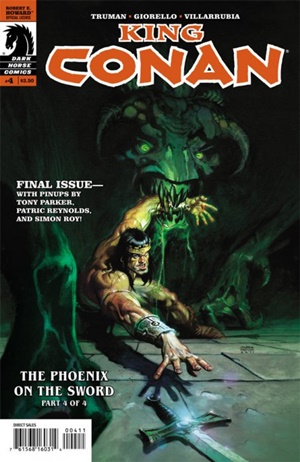 Pretty much the same thing. Though, the writing is a little bit better in the second version. Howard continually honed his skill.
Pretty much the same thing. Though, the writing is a little bit better in the second version. Howard continually honed his skill.
But while the focus of the remainder of the Kull story is instead of fretting over his limitations as king, Howard has Conan dream.
Now, this little dream interlude matters, because Ascalante has a slave named Thoth-Amon. A Stygian, he was once a powerful sorcerer, but he had lost his magical Ring of Set, and was now weak, and in hiding. He is sent to accompany Dion, the totally useless noble, to make sure that the latter doesn’t expose the plot. Dion, who is beyond clueless, has the very ring Thoth Amon seeks. Quickly reclaiming it with a dagger, the sorcerer turns to revenge against Ascalante, using his once-lost dark arts. Unfortunately for Conan, he’s only a few feet away from the potential royal usurper. He’s definitely in the neighborhood of being collateral damage.
Howard was the best prose writer I’ve discovered yet in the fantasy field. He just had a fantastic way with words:
“There was a movement about him, such a swirl as is made in water when some creature rises to the surface. A nameless, freezing wind blew on him briefly, as if from an opened Door. Thoth felt a presence at his back, but he did not look about. He kept his eyes fixed on the moonlit space of marble, on which a tenuous shadow hovered. As he continued his whispered incantations, this shadow grew in size and clarity, until it stood out distinct and horrific. Its outline was not unlike that of a gigantic baboon, but no such baboon ever walked the earth, not even in Stygia. Still, Thoth did not look, but drawing from his gridle, a sandal of his master – always carried in the dim hope that he might be able to put it to such use – he cast it behind him.”
From Thoth Amon staring at the ring he has longed for, through the beast passing by a stunned guard at the palace (which ends chapter three), this is a terrific sequence of writing.
Meanwhile, asleep in his chamber, Conan travels to a magnificent tomb. There he meets the long-dead sage, Epemitrius, who, during his life, fiercely battled the evil snake-god, Set. Epemitrius etches the symbol of a phoenix onto Conan’s sword. Then, Conan wakes in his room and hears stealthy footsteps in the corridor and begins to prepare himself for combat.
The battle scene is similar in both versions, with Kull and Conan trying to avoid harming the mad minstrel (I found that whole ‘a minstrel is greater than a king’ something more fitting for de Camp and Carter than Howard, myself).
With all the rogues either dead or fled (hey, that rhymed!), Ascalante gains the advantage and is about to kill Kull in the original version. Only to have Sena save the day. But there is no Sena and Ala in Conan’s version. And while I think it has been good up to this point, it is here that “The Phoenix on the Sword” really shines and we see Robert E. Howard’s emergence as one of the greatest fantasy writers.
Conan uses his axe-arm to wipe blood from his eyes at precisely the wrong moment. Ascalante, alone and with nothing to lose, rushes at him. The would-be assassin doesn’t quite make it there:
“But even as he began his charge, there was a strange rushing in the air and a heavy weight struck terrifically between his shoulders. He was dashed headlong and great talons sang agonizingly in his flesh. Writhing desperately beneath his attacker, he twisted his head about and started into the face of Nightmare and lunacy. Upon him crouched a great black thing which he knee was born in no sane or human world. Its slavering black fangs were near his throat and the glare of its yellow eyes shriveled his limbs as a killing wind shrivels young corn. The hideousness of its face transcended mere bestiality.”
“In those abhorrent features the outlaw’s dilated eyes seemed to see, like a shadow in the madness that enveloped him, a faint and terrible resemblance to the slave Thoth-Amon.”
I mean, WOW!!! (Yeah, I know. My keen analysis is breathtaking…)
Ascaltante dies of sheer terror: “Then, Ascalante’s cynical and all-sufficient philosophy deserted him, and with a ghastly cry he gave up the ghost before those slavering fangs touched him.”
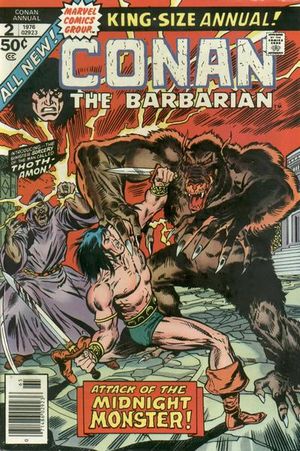 Howard had developed Ascalante in this short story. He is not just a paper-thin supporting character. And he did a fantastic job of having the man, in the absolute horror of his final moments, get at least a flickering understanding that his slave had gotten his revenge. And then, he dies. It’s brilliant work.
Howard had developed Ascalante in this short story. He is not just a paper-thin supporting character. And he did a fantastic job of having the man, in the absolute horror of his final moments, get at least a flickering understanding that his slave had gotten his revenge. And then, he dies. It’s brilliant work.
Which leaves a ‘frozen’ Conan to face this new threat. And in just THREE paragraphs, Howard gives us a marvelous fight between the Cimmerian and the supernatural creature. At this point, I think that “Phoenix” is simply a much more interesting and entertaining story than “Axe!” was.
The creature would have killed Conan, if not for the phoenix etched on his sword by Epimetrius. That allowed the weapon, even though broken earlier in the fight, to fatally wound it.
I think that “By This Axe I Rule!” Is a good enough story. Though, it’s not one I would turn back to very often. Whereas, I’ve re-read “The Phoenix on the Sword” quite a few times. In large part, because I like the swords and sorcery aspect of it.
Thoth Amon was the catalyst, though not actually present, in “The God in the Bowl.” So, Howard had him in mind for two of the first three Conan tales. But he never again used the Stygian sorcerer. And since “Bowl” was rejected by Wright and not published until 1952, he was effectively a one-shot character in the authentic Conan Canon.
That changed, however, when L. Sprague de Camp decided to make him the main antagonist in the barbarian’s life, as he laid out the original and ‘new’ tales as a Conan Saga. The Marvel comics also utilized Thoth Amon, so that he is now generally considered ‘the’ Conan villain.
While it’s not the best Conan story written by Howard, I do think it’s the perfect introduction to Conan. He already has many exploits behind him and is now a king. It’s got a royal assassination plot: and sorcery. And it has the quality writing characteristic of much of Howard’s work.
2025 (3)
Shelfie – Dashiell Hammett
Windy City Pulp & Paper Fest – 2025
Will Murray on Who was N.V. Romero?
2024 Series (11)
Will Murray on Dashiell Hammett’s Elusive Glass Key
Ya Gotta Ask – Reprise
Rex Stout’s “The Mother of Invention”
Dime Detective, August, 1941
John D. MacDonald’s “Ring Around the Readhead”
Harboiled Manila – Raoul Whitfield’s Jo Gar
7 Upcoming A (Black) Gat in the Hand Attractions
Paul Cain’s Fast One (my intro)
Dashiell Hammett – The Girl with the Silver Eyes (my intro)
Richard Demming’s Manville Moon
More Thrilling Adventures from REH
Prior Posts in A (Black) Gat in the Hand – 2023 Series (15)
Back Down those Mean Streets in 2023
Will Murray on Hammett Didn’t Write “The Diamond Wager”
Dashiell Hammett – ZigZags of Treachery (my intro)
Ten Pulp Things I Think I Think
Evan Lewis on Cleve Adams
T,T, Flynn’s Mike & Trixie (The ‘Lost Intro’)
John Bullard on REH’s Rough and Ready Clowns of the West – Part I (Breckenridge Elkins)
John Bullard on REH’s Rough and Ready Clowns of the West – Part II
William Patrick Murray on Supernatural Westerns, and Crossing Genres
Erle Stanley Gardner’s ‘Getting Away With Murder (And ‘A Black (Gat)’ turns 100!)
James Reasoner on Robert E. Howard’s Trail Towns of the old West
Frank Schildiner on Solomon Kane
Paul Bishop on The Fists of Robert E. Howard
John Lawrence’s Cass Blue
Dave Hardy on REH’s El Borak
Prior posts in A (Black) Gat in the Hand – 2022 Series (16)
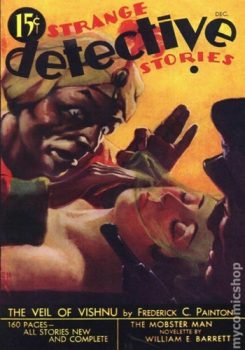 Asimov – Sci Fi Meets the Police Procedural
Asimov – Sci Fi Meets the Police Procedural
The Adventures of Christopher London
Weird Menace from Robert E. Howard
Spicy Adventures from Robert E. Howard
Thrilling Adventures from Robert E. Howard
Norbert Davis’ “The Gin Monkey”
Tracer Bullet
Shovel’s Painful Predicament
Back Porch Pulp #1
Wally Conger on ‘The Hollywood Troubleshooter Saga’
Arsenic and Old Lace
David Dodge
Glen Cook’s Garrett, PI
John Leslie’s Key West Private Eye
Back Porch Pulp #2
Norbert Davis’ Max Latin
Prior posts in A (Black) Gat in the Hand – 2021 Series (7 )
The Forgotten Black Masker – Norbert Davis
Appaloosa
A (Black) Gat in the Hand is Back!
Black Mask – March, 1932
Three Gun Terry Mack & Carroll John Daly
Bounty Hunters & Bail Bondsmen
Norbert Davis in Black Mask – Volume 1
Prior posts in A (Black) Gat in the Hand – 2020 Series (21)
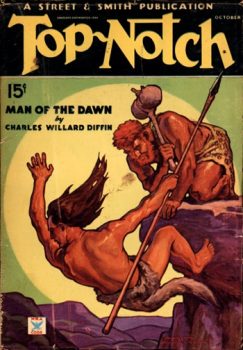 Hardboiled May on TCM
Hardboiled May on TCM
Some Hardboiled streaming options
Johnny O’Clock (Dick Powell)
Hardboiled June on TCM
Bullets or Ballots (Humphrey Bogart)
Phililp Marlowe – Private Eye (Powers Boothe)
Cool and Lam
All Through the Night (Bogart)
Dick Powell as Yours Truly, Johnny Dollar
Hardboiled July on TCM
YTJD – The Emily Braddock Matter (John Lund)
Richard Diamond – The Betty Moran Case (Dick Powell)
Bold Venture (Bogart & Bacall)
Hardboiled August on TCM
Norbert Davis – ‘Have one on the House’
with Steven H Silver: C.M. Kornbluth’s Pulp
Norbert Davis – ‘Don’t You Cry for Me’
Talking About Philip Marlowe
Steven H Silver Asks you to Name This Movie
Cajun Hardboiled – Dave Robicheaux
More Cool & Lam from Hard Case Crime
A (Black) Gat in the Hand – 2019 Series (15)
Back Deck Pulp Returns
A (Black) Gat in the Hand Returns
Will Murray on Doc Savage
Hugh B. Cave’s Peter Kane
Paul Bishop on Lance Spearman
A Man Called Spade
Hard Boiled Holmes
Duane Spurlock on T.T. Flynn
Andrew Salmon on Montreal Noir
Frank Schildiner on The Bad Guys of Pulp
Steve Scott on John D. MacDonald’s ‘Park Falkner’
William Patrick Murray on The Spider
John D. MacDonald & Mickey Spillane
Norbert Davis goes West(ern)
Bill Crider on The Brass Cupcake
A (Black) Gat in the Hand – 2018 Series (32)
George Harmon Coxe
Raoul Whitfield
Some Hard Boiled Anthologies
Frederick Nebel’s Donahue
Thomas Walsh
Black Mask – January, 1935
Norbert Davis’ Ben Shaley
D.L. Champion’s Rex Sackler
Dime Detective – August, 1939
Back Deck Pulp #1
W.T. Ballard’s Bill Lennox
Erle Stanley Gardner’s The Phantom Crook (Ed Jenkins)
Day Keene
Black Mask – October, 1933
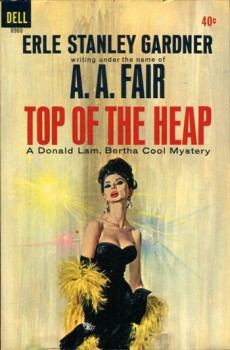 Back Deck Pulp #2
Back Deck Pulp #2
Black Mask – Spring, 2017
Erle Stanley Gardner’s ‘The Shrieking Skeleton’
Frank Schildiner’s ‘Max Allen Collins & The Hard Boiled Hero’
A (Black) Gat in the Hand: William Campbell Gault
A (Black) Gat in the Hand: More Cool & Lam From Hard Case Crime
MORE Cool & Lam!!!!
Thomas Parker’s ‘They Shoot Horses, Don’t They?’
Joe Bonadonna’s ‘Hardboiled Film Noir’ (Part One)
Joe Bonadonna’s ‘Hardboiled Film Noir’ (Part Two)
William Patrick Maynard’s ‘The Yellow Peril’
Andrew P Salmon’s ‘Frederick C. Davis’
Rory Gallagher’s ‘Continental Op’
Back Deck Pulp #3
Back Deck Pulp #4
Back Deck Pulp #5
Joe ‘Cap’ Shaw on Writing
Back Deck Pulp #6
The Black Mask Dinner

Bob Byrne’s ‘A (Black) Gat in the Hand’ made its Black Gate debut in 2018 and has returned every summer since.
His ‘The Public Life of Sherlock Holmes’ column ran every Monday morning at Black Gate from March, 2014 through March, 2017. And he irregularly posts on Rex Stout’s gargantuan detective in ‘Nero Wolfe’s Brownstone.’ He is a member of the Praed Street Irregulars, founded www.SolarPons.com (the only website dedicated to the ‘Sherlock Holmes of Praed Street’).
He organized Black Gate’s award-nominated ‘Discovering Robert E. Howard’ series, as well as the award-winning ‘Hither Came Conan’ series. Which is now part of THE Definitive guide to Conan. He also organized 2023’s ‘Talking Tolkien.’
He has contributed stories to The MX Book of New Sherlock Holmes Stories — Parts III, IV, V, VI, XXI, and XXXIII.
He has written introductions for Steeger Books, and appeared in several magazines, including Black Mask, Sherlock Holmes Mystery Magazine, The Strand Magazine, and Sherlock Magazine.
You can definitely ‘experience the Bobness’ at Jason Waltz’s ’24? in 42′ podcast.
Book Review: Shield of Sparrows by Devney Perry
I received a review copy from the publisher. This does not affect the contents of my review and all opinions are my own.
 Shield of Sparrows by Devney Perry
Shield of Sparrows by Devney Perry
Mogsy’s Rating: 4 of 5 stars
Genre: Romance, Fantasy
Series: Book 1
Publisher: Red Tower Books (May 6, 2025)
Length: 528 pages
Author Information: Website | Twitter
The romantasy genre is more crowded than ever these days, so whenever one stands out, I tend to take notice! While a novel like Shield of Sparrows by Devney Perry may follow a familiar blueprint, it manages to execute it with enough style and panache to feel instantly recognizable but not stale. To my delight, I had a great time with it.
The book follows Princess Odessa, the eldest daughter of the king of Quentis who has spent most of her life in the shadow of her younger half-sister. After all, it is Mae who is the favored child, the one promised to the prince of neighboring Turah, and the one carefully trained to become a spy and uncover the rival kingdom’s deepest secrets. However, when the time finally comes to seal the alliance through marriage, the Turan prince Zavier unexpectedly invokes an ancient rite that allows him to choose Odessa as his bride instead, much to everyone’s surprise.
And thus, with little warning, our protagonist is shipped off to a foreign land alongside her new husband and his loyal soldier, known only as the Guardian. Tasked with furthering her father’s political agenda, Odessa must quickly learn to navigate the unfamiliar ways of the Turan court if she is to one day become their queen, except this is proving far more difficult and treacherous than she ever imagined. While Prince Zavier remains distant and tightlipped about the problems plaguing his kingdom, monsters stalk the wilds and prey on his people, and a mysterious illness spreading across Turah is corrupting everything it touches. At the heart of it all stands the enigmatic Guardian, bound to protect the royal couple yet is shrouded in secrets of his own. Although his insufferable personality constantly frustrates Odessa, it appears that their paths—and perhaps even their destinies—may be inextricably linked.
Through all of this, the main character’s journey gives readers a fast-paced entry into the fantasy world of Shield of Sparrows. Rather than packing her prose with exposition, Perry lets us explore the magic of it on our own, discovering a wondrous landscape featuring mythical beasts and layers of rich history. While the slow trickle of information can sometimes make you feel impatient, the steady ramp up is well worth it in the end as it leads to a result that is both epic and cinematic.
But of course, what everyone wants to know is, how is the romance? I have to say, the character work is where this novel is strongest. First, we have Odessa, a heroine who is initially perceived as unassuming and weak, but her growth over the course of the story is realistic and tangible. Similarly, the book’s romantic arc, which ultimately ends up being between her and the Guardian, is very well written and deliciously paced—no frivolous claims of being slow-burn in the publisher description only to end up being insta-love, thank goodness. Their love story is one that unfolds through sharp dialogue and moments of mutual vulnerability, but the drama never feels intrusive, nor does it ever overwhelm the conflicts that drive the main plot. Sure, there’s still plenty of manufactured angst stemming from dumb reasons like miscommunication and the deliberate withholding of truth, but at least we got a few genuine twists and surprises out of it.
That said, in terms of storytelling, Shield of Sparrows is in no way reinventing the wheel. Still, there are sufficient emotional beats to keep things entertaining and fresh, with thrills frequently injected in the form of monster attacks and court intrigue. Plus, Odessa’s unique experiences in Turah alone are enough to give this story its staying power, not to mention the evolving relationships she builds along the way. Admittedly, the pacing could have used some tweaking, particularly the middle section where the plot meandered and momentum faltered, or the ending where things went the other direction and became pure pandemonium in an instant. Ultimately though, these are relatively minor quibbles.
In short, Shield of Sparrows might not break new romantasy ground, but it doesn’t have to. Genre fans will be happy that it hits all the right notes and provides plenty of reasons to crave the next book. The ending left me reeling, and after all that chaos, I’m going to need some answers.
![]()
![]()
A Challenge Worth Smiling About: Tim Waggoner on Writing Conan

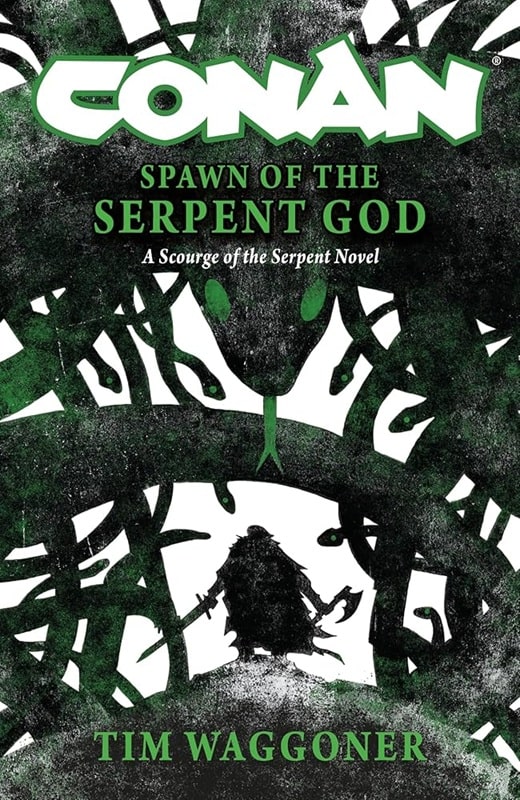
Tim Waggoner, and his upcoming novel Conan: Spawn of the Serpent God (Titan Books, October 28, 2025)
On a non-descript day I am intercepted on entering a coffee shop. It turns out to be a happy accident, an old colleague, eager to join me as I wait for my next interview to begin. The distraction is welcome but doesn’t help much. My interviewee isn’t late but they aren’t early either and I’m beginning to get nervous.
“You’re waiting for him, aren’t you?” the friend asks.
Neither of us mentioned his name because we didn’t have to. Some things, in certain contexts, go together like cheese and tortillas. With four Stoker Awards and many great novels to his name, Tim Waggoner has developed that kind of reputation in this part of Ohio. If Massachusetts is Lovecraft Country then downtown Dayton is Waggonerstan.
[Click the images for Conan-sized versions.]
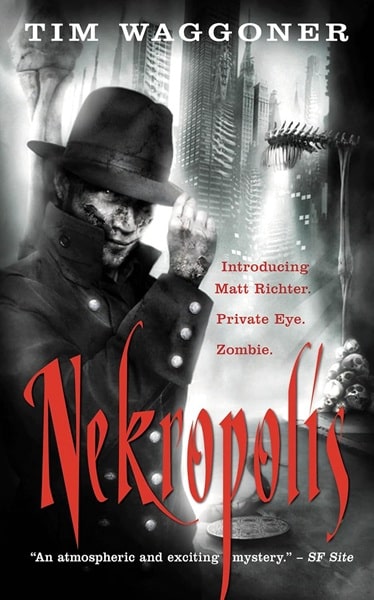
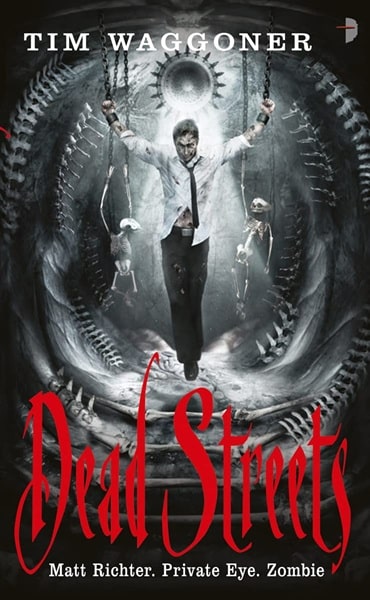

The Nekropolis series by Tim Waggoner: Nekropolis, Dead Streets, and
Dark War (Angry Robot, 2009, 2010, and 2011). Covers by Vincent Chong
“What’s the interview about?”
I swerve the question because this former colleague is a journalist too. When it comes to what Waggoner has to say about the novel we’ve come to talk about, I’d rather get it in Black Gate first. A book the author later estimates is the 62nd or 63rd of his career.
That brief period of forbearance is soon rewarded when Waggoner arrives. I can tell he’s been busy cooking up something special with his new novel. It does not take long before coffee and talk of Conan begins to flow.
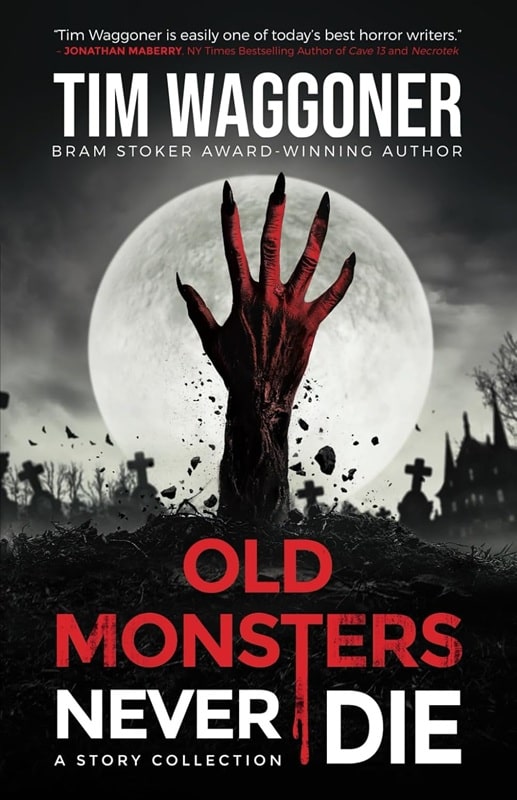
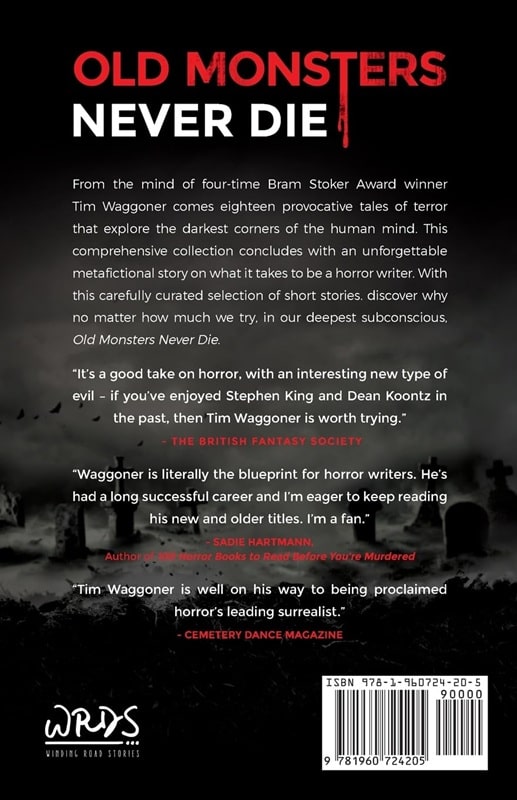
Old Monsters Never Die: A Story Collection by Tim Waggoner
(Winding Road Stories, May 24, 2024). Cover art uncredited
Anyone familiar with Waggoner’s literary career knows he’s worn many hats over the years, dipping his proverbial toe in one genre or another. There’s the Nekropolis series, the fantasy Blade of the Flame novels, and award-winning books on the craft of writing such as Writing in the Dark. Even among those massive projects, trilogies, and the travails every writer faces, working on a Conan novel was a special challenge. In fact, that’s exactly why the first time opportunity came knocking he said no.
“My agent told me Titan was doing Conan and asked if I was interested. I just thought there was no way I could do it because it’s not just about Conan but also the world he inhabited. It’s a very realized world with multiple countries. I just didn’t know if I could do it. After saying no the first time, when I was asked again I just had to do it. I said yes and immersed myself in all the Conan stories I could,” Waggoner told me.
That meant diving deep into the lore of the famous barbarian, going back to the original stories and working his way up to Titan’s ongoing series. It’s clear, however, that like many fantasy fans Waggoner was not coming to Conan blind. This certainly wasn’t his first time in the Hyborian Age.
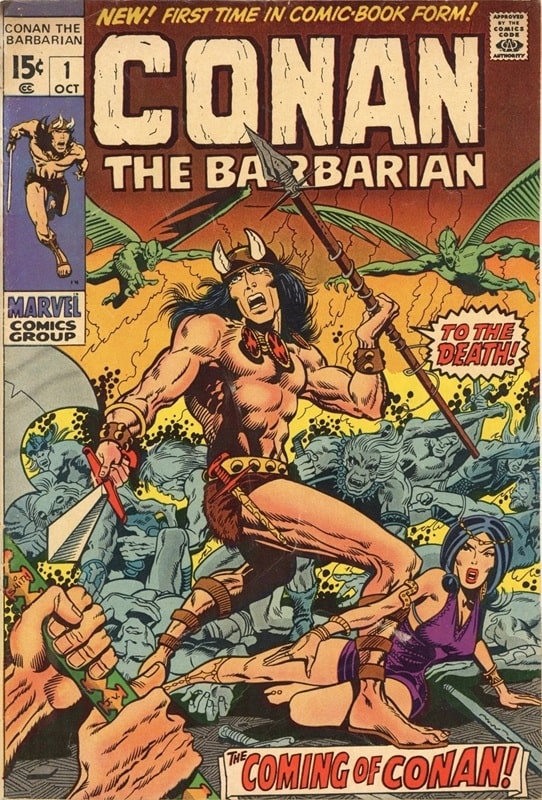

Marvel Comics Conan the Barbarian, issue #1 (Marvel Comics, October, 1970). Cover by Barry Windsor-Smith
“Most of my experience with Conan had been with the comics. As a kid I knew him mostly through Marvel Comics. I had the very first issue for years and wish I’d kept it. I don’t know what happened to it. Probably fell apart I read it so often.”
Through cultural osmosis he learned more about the character through films and other comics. But going back to the original well of creativity that spawned one of fantasy’s greatest protagonists taught him a lot that would serve him well during the writing process. He listened to them on audiobook and read them at home. Waggoner also went on to read the King Kull stories, El Borak, and even Solomon Kane. But it was the stories about Conan that were most integral.
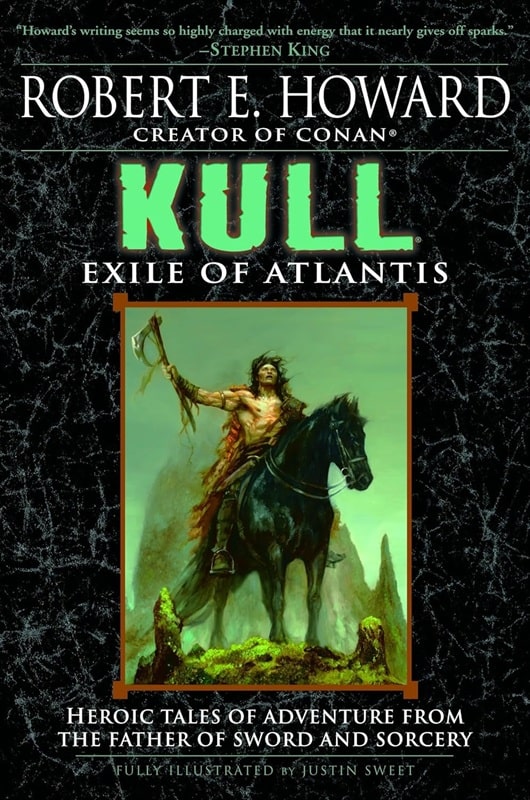
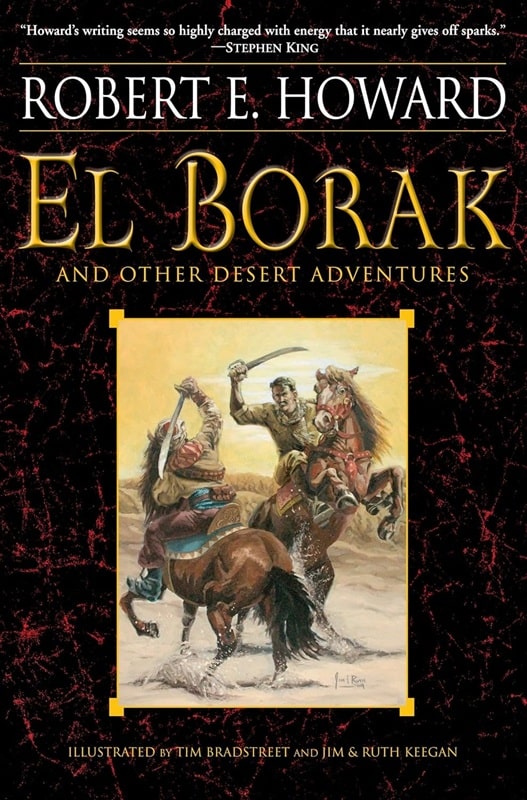
Two Del Rey Robert E. Howard volumes: Kull: Exile of Atlantis, and El Borak and Other Desert
Adventures. (October 31, 2006, and February 9, 2010). Covers by Justin Sweet, and Jim & Ruth Keegan
“It really helped me because the one thing I didn’t get in the comics or in the movies is how much a part of the story the setting is,” he said. “It took me forever to get started on it. I couldn’t figure out where to start but eventually it clicked overall. But a big part of it was realizing the setting was a big part of the story.”
Writing the book was an experience Waggoner described as ‘intimidating’. Who can blame him? Even with decades of experience, taking on a character with such a rich history and fans spanning the globe would challenge anyone.
“I had to try and think of what my version of Conan was because no matter what I knew I wouldn’t be able to write his,” said Waggoner in reference to Howard. “Part of what I did is work that out on the page. Here’s this guy who will critique civilization even as he is drawn to it. I asked myself, ‘why does he do that?’”
One aspect of Conan that fascinated Waggoner is his evolution over time, from thief to pirate to mercenary and eventually king. As the author explains, Cimmerians generally don’t travel outside Cimmeria. Finding out where that thirst for adventure came from was integral to understanding the character.


Two more Del Rey Howards: The Savage Tales of Solomon Kane and
Bran Mak Morn: The Last King (July 2004 and June 2005). Covers by Gary Gianni
“I did find out that in a letter Robert E. Howard wrote that Conan’s grandfather had traveled some, told him stories as a kid, and that was of what woke that in him. While he (Howard) never wrote it in a story that helped me see where part of that aspect of Conan came from. But part of that is just his nature too,” Waggoner explained.
The novel, according to Waggoner, will show readers two sides of the barbarian with the story focused on Conan’s life at 17 and 32. It’s a two-part story separated by 15 years, which helped the author show the titular character’s growth over time. This can be seen in his natural cursiotiy as a teenage thief as well as in his expansive knowledge of other languages and cultures later on. Conan’s interactions with religion and the origin of his unique sense of chivalry are also touched on in the book.
“That’s because when I write any kind of tie-in like this I try to imagine them as real people. If I’m trying to write about Conan being real then I have to ask myself why does he do these sorts of things and why are they so important to his character?”
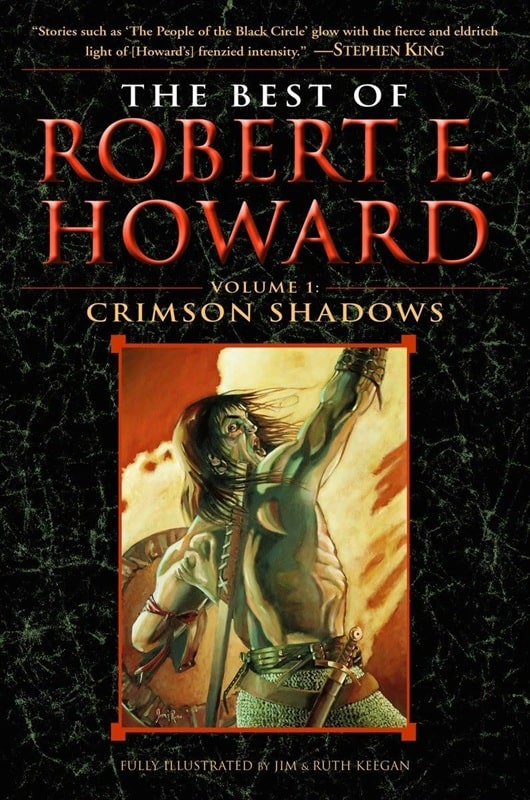

The Best of Robert E. Howard, Volumes 1 & 2: Crimson Shadows and Grim Lands
(Del Rey, August 31, 2009 and December 2007). Covers by Jim Keegan and Ruth Keegan
Its an approach that has worked well in the past and allowed him to touch on a part of Conan a some have missed in the past.
“I think one thing some of the comics and movies miss is that while he (Conan) is dour and grim, that’s not all he is. Howard says in that one description ‘gigantic mirths and gigantic melancholies’. The mirth part you don’t see very much. I tried to put some of that in there. I also tried to show how he had a lot more anger and was quicker to violence at 17 than he was at 32. Over time, he becomes a lot more skilled.”
Of course, given the amount of time left between now and the book’s listed Oct. 27 publication date, things may change and edits might be made. Waggoner admits that some of what he wrote might be edited out though he is hopeful. Midway through the conversation I mention Conan’s connection to Cthulhu and Waggoner’s answer leaves me hopeful too.
“I tried to include some of that too,” he said with a smile.
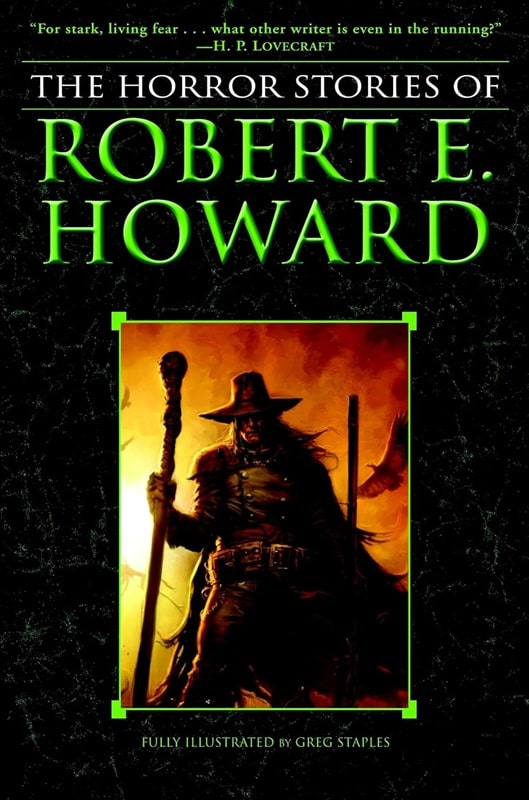
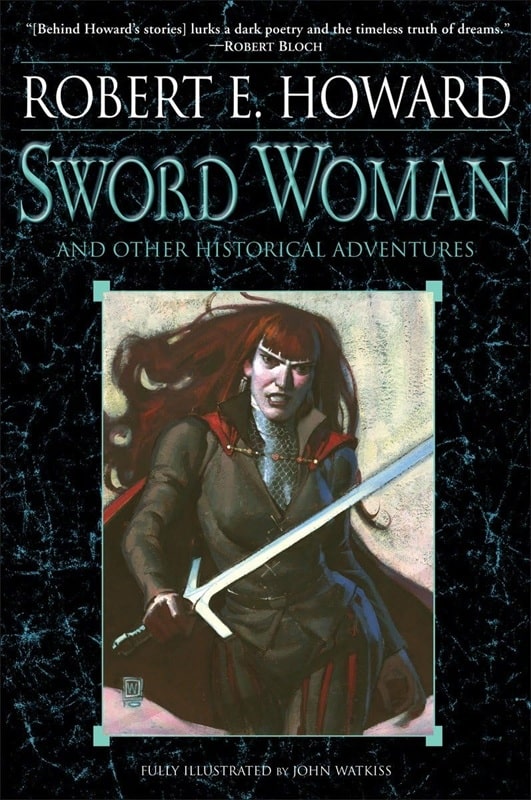
The Horror Stories of Robert E. Howard and Sword Woman (Del Rey,
July 29, 2008 and January 25, 2011). Covers by Greg Staples and John Watkiss
Regardless, its clear a ton of work has gone into making the novel as best as it can be. When Conan: Spawn of the Serpent God does come out, it will be a welcome addition to many bookshelves around the world. And if Titan’s release schedule is anything to go by, the beloved sword-wielding warrior shows no signs of slowing down. Conan, its no exaggeration to say, is thriving.
“I think he’s endured so long because he’s the same sort of character, ultimately, as the lone gunslinger or the private eye. He’s the individual that is true to himself and can be himself in whatever society he’s in,” Waggoner said.
But there is one other ingredient the author feels separates Conan from the pack. One so important it leaves other legacy characters like Sam Spade and The Shadow in the dust.
“With Conan his motive ultimately is adventure. It’s living life and experiencing it absolutely to the fullest. You don’t see that in a lot of warrior type characters. You don’t see that in the lone gunslinger. The private eye is usually depressed. Conan, however, I don’t think we even know what happens to him at the end of his life because eventually he tells his son ’you be king, I’m out of here’ and just goes adventuring all over again,” Waggoner said with a laugh.
Ismail D. Soldan is an author, journalist, and poet. His work has previously appeared in Illustrated Worlds, LatineLit, and The Acentos Review among other publications. A proud explorer of both real and imagined worlds, his most recently published short story can be read in the January 2025 issue of Crimson Quill Quarterly, and his last article for Black Gate was New Adventures for the World’s Favorite Barbarian.
Tubi Dive, Part V


Meatball Machine and Meatball Machine Kodoku (TLA Releasing, 2005 and 2017)
50 films that I dug up on Tubi.
Enjoy!
Meatball Machine (2005) and Meatball Machine Kodoku (2017)It’s a double-header in more ways than one, as I settled down to watch a couple of films that bookend a period known to cinephiles as Gonzo Japanese Splatter. Between these films, we were served up classics such as Tokyo Gore Police, Machine Girl, and the afore-reviewed Toilet of the Dead and Dead Sushi, but those are just the tip of the grue-coated iceberg.
If you are familiar with Tetsuo: The Iron Man from 1989, you’ll already have a grasp of the themes in these films; isolation, sexual desire, transformation, body horror and extreme gore.
Meatball Machine was directed by Yūdai Yamaguchi with effects by long-time Noboru Iguchi collaborator Yoshihiro Nishimura (Nishimura would later go on to direct the Meatball sequel). It looks like it was shot on digital video, with blown out colors, and I’m not a fan, but that could also be down to the dodgy copy Tubi has.
The story concerns Yōji, a downtrodden young man who has a rubbish job and stifles his loneliness by pining for a young woman, Sachiko, whom he watches from afar during his lunch breaks. In the background of this sob story, we learn that parasites are taking over people and mutating them into killing machines, for reasons.
Yōji stumbles across the carapace of one of these creatures and takes it home. One night, after saving Sachiko from a sexual assault, they finally get to sit and talk, and discover they are both lonely. This is all building up to a sweet moment, but then the carapace springs into life, attaching itself to Sachiko and OH MY FREAKING GOD. Yamaguchi cranks everything up to 11 and covers everyone in dripping gore throughout the rest of the film. It’s wild, utterly bonkers, and ridiculously entertaining (if you like that sort of thing, you disgusting person, you). Multiple fights and plot twists ensue, and a new sub-genre is kickstarted into horrific life.
Meatball Machine Kodoku takes the idea in a completely different direction, leaning heavily into an aliens angle while also expanding upon the lore. Director Nishimura, always on the lookout to outdo himself and everyone else in the genre, goes completely potty, coming up with some of the weirdest and most wonderful body transformations I have ever seen.
In this film, Yuji, a downtrodden, middle-aged man who hates his debt collecting job, secretly pines for a cute young woman, Kaoru, who works in his local bookstore. When he saves her from a potential assault, they finally get together and, yes, you guessed it, everything goes to poop. So far, so very similar.
However, this time the parasites infest a whole city, not only that, but they trap the entire city in a giant alien bell jar, and let everyone kill each other. For reasons.
One aspect I enjoyed about this one was that when mutated by a parasite, your body’s weapon is the thing you are most recently connected to. So a construction worker gets a jackhammer for an arm, while a burlesque dancer who was eating spaghetti ends up with a fork. It’s especially fun watching the parasites control their hosts with outlandish levers in their little pod ‘brains.’ This film is actually light on horror for the first 30 minutes, and then BOOM — a chopped off willy and a bisected pair of lovers kick off the whole shebang — and it all gets set to ludicrous speed.
It’s hard to elicit any sympathy for Yōji and Yuji, as in both films they immediately objectify their love interests, but in the end you can’t help rooting for them.
Naturally, if you have an aversion to extreme body horror, writhing tendrils, copious amounts of gore, boob and pantie obsessions and tasteless deaths, then these aren’t the films for you. However, I laughed a lot, and not necessarily at the right moments.
Let me know if you watch them!
7/10 and 8/10 respectively
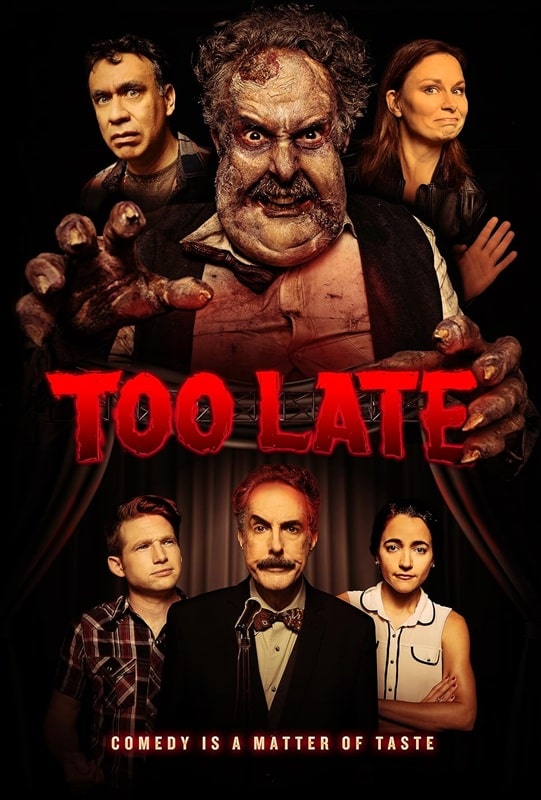
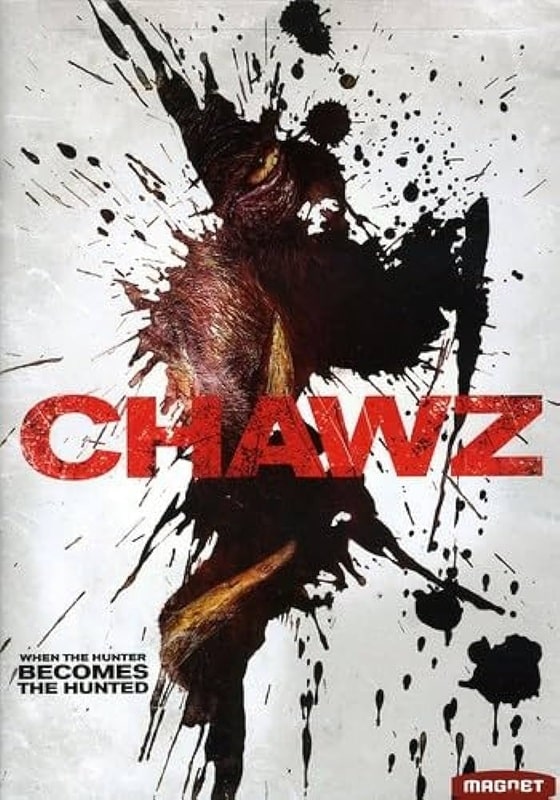
Too Late (Vanishing Angle, June 11, 2015) and Chawz (Lotte Entertainment, July 16, 2009)
Taking a break from gonzo Asian splatter-fests, I found myself settling in for what one might describe as a ‘cozy’ horror-comedy. Personally, I’d describe it as a missed opportunity, but a cursory glance at other reviews reveals I’m in the minority, so what do I know?
Violet (Alyssa Limperis) is the assistant to a famous stand-up comedian, Bob Devore (Ron Lynch), and she helps him find new talent for his late-night live show, Too Late. He doesn’t just need raw talent to entertain his crowds though, as Bob is a supernaturally old, shape-shifting monster that has to eat every four weeks. He’s been in the entertainment business a very long time, and only the most talented acts will sate his hunger. When Violet falls in love with one of his potential meals, she must find a way to terminate her contract and save herself. And that’s about the gist of it. A not-so-subtle allegory for the destructive nature of showbiz.
I’m good with this. It’s a solid concept and the film is well-shot and directed, and for the most part well acted. Fred Armisen and Mary Lynn Rajskub pop up for short cameos, mainly, I suspect, to help get the film funded and to put on the DVD cover, and the rest of the cast is filled out with the usual roster of genre types. They all do their jobs admirably. The horror itself is fairly tame, and other than a shot at the end, relatively bloodless, and I didn’t mind that either.
What I did object to though was the notion that this all takes place against the backdrop of a comedy club, and not a single one of the performers was funny. I get it. Comedy is subjective, but come on, some of this was the dullest observational humour I have ever heard. Not the main focus of the story, but it still irked me enough to get salty as I watched it.
Bottom line, OK.
5/10
Chawz (aka Chaw) (2009)The Korean title Chaw translates to ‘trap’, but this creature feature wears its influences on such a large sleeve, that it was rebranded to Chawz for its US release, capitalizing on that old shark movie.
I’ve been a sucker for giant, mutant boar movies ever since I first watched Russell Malcahy’s Razorback back in the day. Sadly, they are a bit thin on the ground, but this is a good one, so I’m glad I caught up with it.
It’s your usual monster movie fare; giant creature terrorizes a village, eats folk, is a bit of a nuisance etc., plucky group of tropes band together to hunt it down. So far, nothing new. However, this being a Korean film, it has to meet the 2 hour run time, so there is a lot more going on with a broad roster of characters. We have a fish out of water tale with Kim Kang-soo, a freshly transferred cop, a revenge tale with Chun Il-man wanting to avenge his grand-daughter’s savage death, some light comedy via a clutch of goofy cops and hangers-on, a doomed romance, a crazy lady, an incompetent official, etc etc.
It’s a lot to follow, and the film would benefit from a bit of pruning, but on the whole I had fun with it. The monster effects are fine; a combination of puppetry and B-tier CG, and there are plenty of homages littered throughout to prompt a drinking game.
It’s no The Host, but still worth a look.
7/10
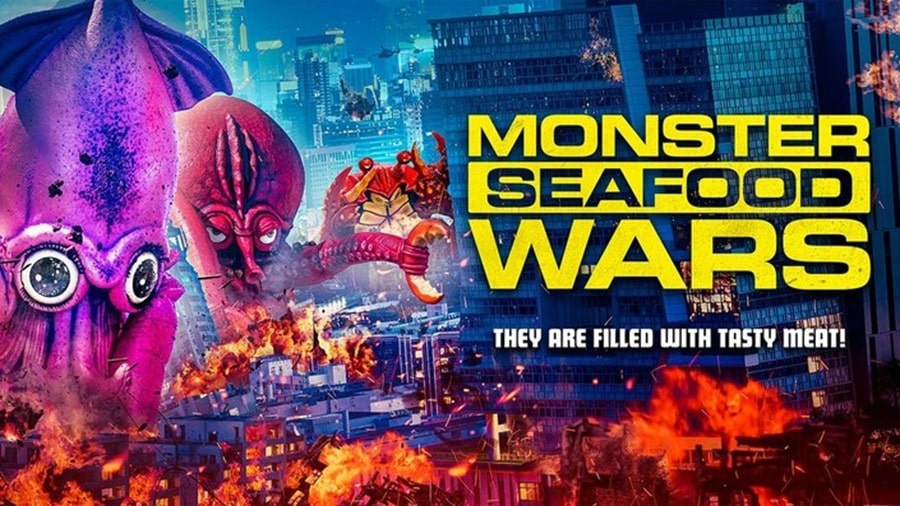 Monster Seafood Wars (Pal Entertainments, June 6, 2020)
Monster Seafood Wars (2020)
Monster Seafood Wars (Pal Entertainments, June 6, 2020)
Monster Seafood Wars (2020)
Never one to turn my nose up at a kaiju slam-fest, I started this one with some trepidation, and was wise to do so. It’s all rather maddening. Stuck inside this ‘comedy’ is a decent monster flick idea; a young slacker scientist creates a serum that can make creatures grow huge in an effort to cure world hunger. His invention is stolen by a nefarious rival, who also steals his shrine offerings (a squid, an octopus and a crab), which are then mutated to ridiculous size and promptly go on a rampage.
The aspect I really enjoyed was the fact that the populace discovers these kaiju are delicious, and so they are happy to let them fight while they control them with vinegar cannons, so that chunks get knocked off and turned into gourmet dishes. That’s what the story should have focused on — it’s a great hook that could allow some excellent moral dilemmas, but instead we have to wade through a tedious love triangle and unnecessary ‘mockumentary’ interviews with the witnesses to the shenanigans.
It also doesn’t help that the monsters themselves are cutesy mascot-style designs with googly eyes and fixed expressions. I wonder how awesome this film could be with realistic creatures and a focus on their deliciousness.
Oh well.
5/10


Blood Surf (Trimark Pictures, December 4, 2000) and Body Melt (Beyond Distribution, December 15, 1993)
If you know me by now, I’m always up for a killer crocodile/alligator flick, and when I learned that the late, great John Carl Buechler was responsible for the reptile effects, I got mistakenly excited.
You see, it’s a film about a hugely unlikable group of MTV brats who want to film themselves surfing with chum-crazed sharks, but instead get roped into a croc of shit. The effects are not good, lots of dodgy superimposition, and the filmmakers had no idea how to shoot the big croc puppet. The script is aggressively dumb, the actors deliver their stupid lines with zero interest, and the whole thing is a crushing bore.
What with a Jürgen Prochnow ordered off of Wish, a Matthew Lilliard/Seann William Scott hybrid, and two girls flashing their tits at the beast before one says, “I guess that’s what you call a croc tease,” I was done with it all.
The one single redeeming feature was that one character was called Melba, which allows me to make a ‘Melba was quickly toast’ joke.
Bah.
1/10
Body Melt (1993)Here’s a strange one from down under — a gonzo, sci-fi, body-horror goo-a-thon starring Ian (Harold Bishop from Neighbours) Smith as an evil doctor. Brilliant bit of casting.
The story is about an immoral pharmaceutical company that doles out free pills to the residents of a small community, and then records the various side-effects. Side effects include: exploding body parts (heads, willies, that sort of thing), sentient placentas, randomly placed tentacles, cannibalism, and various amounts of melting.
As you might be able to discern, there are no set rules to the side-effects, and this is the downside to the film. Rather than tell a coherent story, it plays out more as a series of gloopy vignettes, and we really don’t have a main protagonist to follow.
That said, it’s quite ridiculously fun, and there’s plenty of weird stuff going on (and one or two big laughs), so I’m recommending it to all the weirdos out there.
6/10
Previous Murkey Movie surveys from Neil Baker include:
Tubi Dive, Part I
Tubi Dive, Part II
Tubi Dive, Part III
Tubi Dive, Part IV
What Possessed You?
Fan of the Cave Bear
There, Wolves
What a Croc
Prehistrionics
Jumping the Shark
Alien Overlords
Biggus Footus
I Like Big Bugs and I Cannot Lie
The Weird, Weird West
Warrior Women Watch-a-thon
Neil Baker’s last article for us was Part IV of Tubi Dive. Neil spends his days watching dodgy movies, most of them terrible, in the hope that you might be inspired to watch them too. He is often asked why he doesn’t watch ‘proper’ films, and he honestly doesn’t have a good answer. He is an author, illustrator, teacher, and sculptor of turtle exhibits. (AprilMoonBooks.com).
6 Great Audiobooks You Can Enjoy (On audiobooks.com!)
In this LitStack Rec, we take a look at 6 great audiobooks. The voice performances…
The post 6 Great Audiobooks You Can Enjoy (On audiobooks.com!) appeared first on LitStack.
THE INCANDESCENT by Emily Tesh
COVER REVEAL: Dragon Along (The Dragons of Nóra #2) by Joseph John Lee

Official Author Website
Preorder Dragon Along over HERE
Dragon Along ARC Sign-up Sheet
Joseph John Lee is an author whom we love at Fantasy Book Critic. He's the author of The Spellbinders & the Gunslingers trilogy. We were so thrilled to be a part of the cover reval for the concluding vlume of the Dragons of Nóra duology.
Dragon Along will be releasing on June 3rd 2025 & here's the cover in all of its glory and do checkout the blurb below

Official Blurb: Sometimes, the promise of a different story doesn’t quite go the way you planned.
After the adventure of a lifetime and hatching a dragon of his own, Camaráin promises his mother that they won’t be forced on the same journey his sister embarked on. That pledge appears to have happened a bit too literally: for as much as Camaráin’s hatchling Brían loves to sit and read with him, they share neither the Bond nor the friendship that Camaráin’s sister had with her dragon.
When his grandparents invite the family to their new home outside the capital city of Mór, Camaráin thinks the extent of his new story is getting rid of the belligerent gnome that has taken up residence in his grandparents’ bathroom. At least, until the gnome forms an instant rapport with Brían that leaves Camaráin flummoxed—and also quite jealous.
If Camaráin is to discover why he cannot form a Bond with his new dragon, he must navigate the strange webs of Mór spun by a secret scholarly society, a band of fae hunters, tourists taking up too much space, and the banned books section at the local library.
Evidently, the days of bonding over books and a cuppa have yet to make their way to the land of Nóra.
Tor Doubles #5: Poul Anderson’s No Truce with Kings and Fritz Leiber’s Ship of Shadows
 Cover for No Truce with Kings by Royo
Cover for No Truce with Kings by RoyoCover for Ship of Shadows by Robin Wood
Both Poul Anderson’s No Truce for Kings and Fritz Leiber’s Ship of Shadows originally appeared in issues of The Magazine of Fantasy and Science Fiction, Not only did their initial publication occur in the same periodical, but both of those original issues sported covers painted by Ed Emshwiller.
No Truce for Kings was originally published in F&SF in June, 1963. It won the Hugo Award and received a Prometheus Hall of Fame Award in 2010. No Truce for Kings In is the first of three Anderson stories to be published in the Tor Doubles series.
Colonel James Mackenzie is the commander of Fort Nakamura in a post-apocalyptic California who receives a message that Judge Brodsky has been deposed and replaced by Judge Fallon. This message is the indication to Mackenzie that a civil war has broken out. Although Mackenzie and his troops are loyal to the old regime, the letter makes it clear that Mackenzie’s son-in-law, Thomas Danielis, is aligned with the rebels, as well as serving as a hostage for the troops who are coming to relieve Mackenzie of his command.
The story alternates between Mackenzie’s and Danielis’ actions in the subsequent war, and although Anderson includes many indicators of what the old regime looked like, with a series of local feudal lords called bossmen, and the attempts to destroy that society by the forces of Fallon and his allies, the use of time jumps throughout the story give it a somewhat disjointed feel. However, the use of a Mackenzie and Danielis, as relatives, along with the occasional appearance and frequent mention of Laura, Mackenzie’s daughter and Danielis’ wife, as well as her pregnancy and the birth of her child, combine to give the discussions of tactics and strategies a more personal flavor throughout the story.
While No Truce for Kings starts out as a pretty generic post-apocalyptic story, Anderson adds in an alien element that sets it apart. His aliens, who mostly appear in conversation with themselves as observers of the actions of the humans seem as if they are a response to the psychohistorians of Isaac Asimov’s Foundation series, which was originally published twelve years before No Truce for Kings. These aliens make use of psychodynamicism to guide the events of the humans as they come out of the fall of civilizations. Furthermore, while Asimov created the religion of scientism to help guide the galaxy, Anderson’s aliens have introduced Espers, people who ostensibly have psychic abilities.
The interludes have only a minor direct impact on the action of the story, but they allow Anderson to provide the information the reader needs so the main characters can continue interacting with their world without providing a data dump and allows the reader to have additional background knowledge they don’t have. When Mackenzie comes into contact with a group of Espers, who are theoretically neutral in the war between Fallon and Brodsky, the information Anderson has provided in the discussion of his aliens provides more depth to the Espers’ actions that may seem odd to Mackenzie but can be explained away, except the reader has an understanding where he has gone wrong.
Anderson doesn’t just place Danielis and his father in law on opposite sides of the war, he provides them with a reason for being on those sides. Mackenzie grew up in the system of bossmen and thrived because of it. To him it was the natural order of things. Danielis was an orphan who had to work his way up through the system, eventually succeeding in a military career. He was helped along the way by the Espers, and although they were officially neutral, there is no point in the story that it doesn’t seem like common knowledge that they are supportive of Fallon’s rebellion.
Eventually, of course, the existence of the aliens becomes known and changes the course of the war. The forces of Fallon and Brodsky, all of whom are aware that there was once a more unified country that had collapsed and all of whom have hopes to reestablish in their own ways, suddenly become aware that there is more out there, and can offer them a higher level of technology than humans had previously had access to. This is an area that Anderson had previously explored in works like The High Crusade, published three years before No Truce for Kings. Although Anderson addresses the dichotomy of science, it is done in an almost cursory manner, providing the story with something of an anticlimax from that point of view.
At the same time, his decision to follow Danielis and Mackenzie throughout, focusing on their experiences and the stresses caused by the knowledge that they were on opposite sides of the civil war, imbues the story with a human connection that ultimately does come to a satisfying conclusion, even if the situation does not allow for a happy outcome for all who are involved.
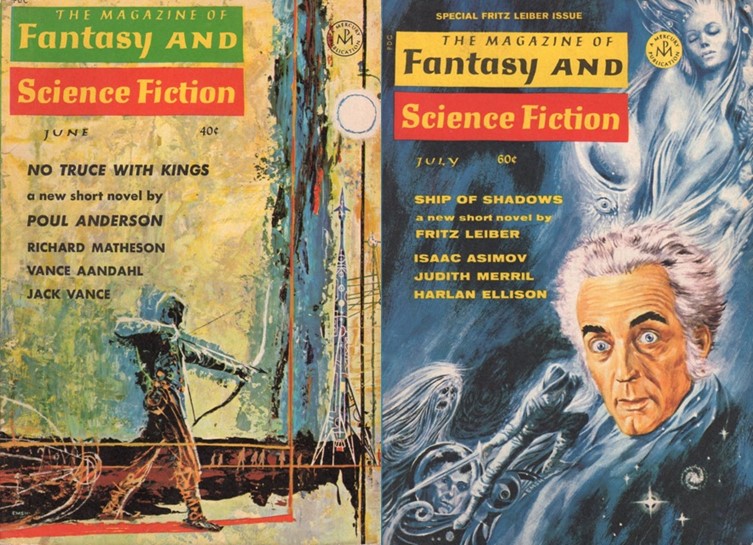 Fantasy and Science Fiction 6/63 cover by Ed Emshwiller
Fantasy and Science Fiction 6/63 cover by Ed EmshwillerFantasy and Science Fiction 7/69 cover by Ed Emshwiller
Ship of Shadows was originally published in F&SF in July, 1969, which was an issue dedicated to Fritz Leiber and included a portrait of him by Ed Emshwiller on the cover. The issue included essays on Leiber by Judith Merril and Al Lewis as well as a reprint of Leiber’s recent poem “iix. ‘Out the frost-rimmed windows peer,…’” and this original novella. Ship of Shadows was nominated for the Hugo Award and the Nebula Award, winning the former. Ship of Shadows is the first of four Leiber stories to be published in the Tor Doubles series, including two that would be published in the final official release of the series.
There is a saying that science fiction (and fantasy) stories have to teach the reader how to read the individual story. The readers must be taught which words should be taken literally and which can be understood metaphorically. Nothing about the story’s setting can be assumed and the reader should allow the author to explain where the story is taking place. Leiber is more than happy to keep the reader in the dark about the actual location in which Ship of Shadows takes place, only revealing the details slowly.
The reader’s entry into this world is Spar, an older man who works as a bartender at the Bat Rack, a dive which serves moonmist, a low grade alcohol. Spar is accompanied by Kim, a talking cat who seems to be his closest friend, although Spar also has a connection with his boss, Keeper, and several of the bar’s patrons, ranging from Doc to Crown to the various women who frequent the bar. Those relationships range from awkwardly cordial to almost adversarial.
Spar has bad teeth and can barely see. He prefers to stay in his menial job at the Bat Rack rather than explore the world around him, taking comfort in the known space, even though it is relatively clear to the reader that even those who seem to have affection for Spar do not respect him or see him as an equal. Even Kim appears to view Spar more as a means to an end.
The world he inhabits appears to be one in which witches and zombies move with impunity, a four day week is in place which includes days for work, idleness, play, and sleep. The world, referred to as Windrush, may also be a ship of some sort, although the characters are not fully aware of its nature. How much of Spar’s knowledge of his world is accurate, how much is legend, and how much is authorial misdirection only becomes partially clear as the novella continues.
Just as Spar seems to have a limited understanding of the world in which he lives, Leiber isn’t in any hurry to provide the reader with any details. It isn’t until he is sent on an errand by Keeper that the world begins to come into an sort of focus, perhaps reflective of the fact that during the errand Spar plans to make a stop to see Doc and have him provide Spar new teeth and new eyes. In his travels, Spar discovers a that Windrush has a variety of different neighborhoods which don’t quite mesh with the world he has pictured living and working in the Bat Rack.
His travels take him to the Bridge, a world of “irregularly pulsing rainbow surfaces, the closest of which sometimes seemed ranks of files of tiny lights going on and off—red, green, all colors. Aloft of everything was an endless velvet –black expanse very faintly blotched by churning, milky glintings.” This revelation, which will be recognized by readers, is strengthened by the fact that it is described through Spar’s imperfect eyesight, which further reinforces the idea that, through no fault of his own, Spar’s impressions of his world of unreliable.
Because of the amount of information Leiber keeps hidden from the reader (and his characters), Ship of Shadows is the sort of work that benefits from re-reading. The first pass lives the reader at a loss for much of the story, but once the explanations come late in the tale, they can illuminate the earlier action when read with the knowledge of what Leiber will eventually reveal.
The cover for No Truce for Kings was painted by Royo. The cover for Ship of Shadows was painted by Robin Wood.
 Steven H Silver is a twenty-one-time Hugo Award nominee and was the publisher of the Hugo-nominated fanzine Argentus as well as the editor and publisher of ISFiC Press for eight years. He has also edited books for DAW, NESFA Press, and ZNB. His most recent anthology is Alternate Peace and his novel After Hastings was published in 2020. Steven has chaired the first Midwest Construction, Windycon three times, and the SFWA Nebula Conference numerous times. He was programming chair for Chicon 2000 and Vice Chair of Chicon 7.
Steven H Silver is a twenty-one-time Hugo Award nominee and was the publisher of the Hugo-nominated fanzine Argentus as well as the editor and publisher of ISFiC Press for eight years. He has also edited books for DAW, NESFA Press, and ZNB. His most recent anthology is Alternate Peace and his novel After Hastings was published in 2020. Steven has chaired the first Midwest Construction, Windycon three times, and the SFWA Nebula Conference numerous times. He was programming chair for Chicon 2000 and Vice Chair of Chicon 7.
Bewitching the Orc Chief - Book Review by Voodoo Bride
 Bewitching the Orc Chief (Silvermist Mates #1)by Chloe Graves
Bewitching the Orc Chief (Silvermist Mates #1)by Chloe GravesWhat is it about:The most potent magic is sealed with a bite.
MirandaAll I wanted was one night of normal after a year of... avoiding my former coven. Instead, I got an orc chief who took one look at me and growled "mine." One scorching night later, I wake up in his village—which is definitely not what I had in mind for the morning-after.
Now I'm surrounded by suspicious orcs, trying to keep my magic under wraps, and fighting an inconvenient attraction to my very large, very possessive "host." But hey, at least my familiar likes him—the traitor.
OsenThe clan elders demand I take a mate to secure my position as chief. I didn't expect fate to hand me a witch who makes my blood burn and my instincts roar to mark her again. And again.
Our shaman spits venom about dark magic, while my uncle circles like a vulture. But when my brother lies bleeding out and her forbidden power yanks him back from the brink, I know I'll burn down tradition to keep her.
Then her coven tracks her to my mountains, and I discover exactly what kind of darkness my mate has been running from. They want to drain her magic and steal her power—but they'll need to go through me first.
My mate. My witch. And I'll destroy anyone who tries to take her from me.
What did Voodoo Bride think of it:I really enjoyed Vexing the Grumpy Orc, so I decided to get the other books in this series as well. So after starting this series with book 3, now it was time for book 1.
If I had started with this book it would have been immediately clear this is Urban Fantasy Romance. The Orc village feels really Other World Fantasy, but outside of their village things are modern. This book made that immediately clear, where book 3 took some time to get away from the village.
I liked the overall story and romance well enough, but this romance had one major turn-off: How much Osen kept mentioning his brother during one of the steamy scenes. I mean: if anyone would do that with me, I'd be out of there, Mate or not. I usually am not one to skim steamy scenes, but here I totally did.
That aside: I liked the book well enough, but I didn't connect with Osen or Miranda as much as I did with Galan in Vexing the Grumpy Orc. I still liked it enough that I'll read book 2 soon.
Why should you read it:It's an enjoyable Orc Romance
Audiobook Review: The Maid’s Secret by Nita Prose
I received a review copy from the publisher. This does not affect the contents of my review and all opinions are my own.
 The Maid’s Secret by Nita Prose
The Maid’s Secret by Nita Prose
Mogsy’s Rating (Overall): 4 of 5 stars
Genre: Mystery
Series: Book 3 of Molly the Maid
Publisher: Random House Audio (April 8, 2025)
Length: 11 hrs and 3 mins
Author Information: Website
I’ve been following the Molly the Maid series since The Maid which first introduced its unforgettable protagonist to readers, so it is with a mix of warmth and bittersweetness that I approached The Maid’s Secret. Although I can’t say with a hundred percent certainty, judging by the emotionally satisfying conclusion and the way everything seemed to be neatly tied up, I suspect this may very well be Molly Gray’s last case.
This time around, life is looking up for Molly. In The Mistletoe Mystery novella published shortly before this novel, her boyfriend Juan Manuel proposed so now the couple is joyfully preparing for their upcoming wedding. But holding dual roles as Head Maid and Special Events Manager at the Regency Grand also means Molly is kept quite busy, especially when an upcoming episode of the popular antique appraisal series Hidden Treasures is set to be filmed at the hotel. When the show’s charismatic hosts, Brown and Beagle, invite the staff to take part in the event, Molly decides to throw together a few of her late grandmother’s keepsakes in a simple shoebox to bring along.
Much to everyone’s surprise, a sparkly bejeweled egg among Gran’s old possessions turns out to be a priceless Fabergé prototype. Announced in front of a live audience, the news catapults Molly into the spotlight and turns her into an overnight celebrity. With the egg’s value appraised at millions of dollars, she also suddenly finds herself fielding questions about whether she will sell it and what she might do with the fortune if she does. After all, with that much money, she and Juan Manuel would be able to have the wedding of their dreams, not to mention financial stability for the rest of their lives. But just as things seem too good to be true, the egg is stolen in a brazen heist, and Molly finds herself embroiled in another high-profile mystery.
As it turns out, the only clues as to who stole the priceless heirloom may lie in a newly discovered diary written by Gran, whose secret past as a wealthy young heiress ends up being the key to everything. The end result is a novel created by two separate, alternating narratives: one that follows Molly’s present-day investigation, and another that reveals Gran’s coming-of-age tale as young Flora Gray.
This dual timeline structure adds a deeper layer of emotional resonance to The Maid’s Secret by exploring the protagonist’s family legacy, thus making it far more complex than its predecessors beyond just a simple whodunit. While the cozy charm of the Regency Grand still grounds this story, Gran now shares the spotlight with Molly through her diary entries, which are addressed to her beloved granddaughter. These chapters add a historical touch and no small amount of nostalgia as they unfold with poignant drama, chronicling Flora’s struggles against her cold, controlling parents. Determined to secure their daughter’s future with a marriage into another wealthy family, they are blindsided when Flora chooses to follow her heart instead, engaging in a forbidden romance with a servant’s son.
Inevitably though, the focus is shifted away from Molly and her friends and colleagues in the present, which may disappoint readers who were expecting more from the tightly knit Regency Grand group. Young Gran’s chapters feel like a world away in comparison, and if you came to this book for more Molly, this unexpected turn of events might feel a bit like a bait-and-switch. Nevertheless, Flora’s past provides essential context for the furor surrounding the central mystery regarding the stolen Fabergé, and personally I found her backstory fascinating. As someone who has always loved the sweet, heartwarming nature of the relationship between Molly and Gran, I felt that the latter’s diary entries managed to bring the series full circle with beautiful purpose.
To sum it all up, if The Maid’s Secret is indeed the series’ finale, in my opinion you couldn’t ask for a more fitting conclusion. Molly remains a singular and beloved character who has grown so much over the last three novels, and I had fun watching every moment of her journey. The stories in these books might not be the most thrilling or unpredictable, but they are warm and comfortable and uplifting, like a favorite sweater or a hot cup of tea on a chilly day. A well-deserved round of applause also goes to Lauren Ambrose for her impeccable work as narrator on these audiobooks. Listening to this whole series has been an absolute joy.
![]()
![]()
More on The BiblioSanctum:
Review of The Maid (Book 1)
Review of The Mystery Guest (Book 2)
Review of The Mistletoe Mystery (Book 2.5)
Goth Chick News: Exploring GalaxyCon’s Newest Addition – Nightmare Weekend
 Nightmare Weekend Chicago 2025
Nightmare Weekend Chicago 2025
One of the most entertaining aspects of working for Black Gate is hitting the road with Photog Chris Z to cover horror-themed events in the Midwest. Though many people think about Halloween during the fall months, there is an enormous subculture of vendors, artists, and fans for whom the spooky season never ends. This year, Chicago was not only the site of an entirely new show just for this audience but also the first city to host it—and we had a front-row seat on opening night.
GalaxyCon, LLC, founded in 2006 by Mike Broder and based in Fort Lauderdale, Florida, is one of the leading organizers of pop culture conventions in the United States. Initially focused on comic books, anime, and broader fan engagement, GalaxyCon has successfully expanded its portfolio to include horror-themed entertainment with its Nightmare Weekend series.
 The crowd at Nightmare Weekend Chicago 2025
The crowd at Nightmare Weekend Chicago 2025
The expansion into horror began in response to the genre’s increasing popularity, particularly its blend of nostalgia, cult fandom, and crossover appeal to mainstream audiences. With Nightmare Weekend, GalaxyCon has carved out a distinct identity in the horror convention scene, blending celebrity meet-and-greets, specialized vendors, themed parties, and curated entertainment.
The Nightmare Weekend events (of which there are four more in other cities this year) reflect Broder’s business philosophy of engaging fans across diverse interests. “Horror is not just a genre; it’s a lifestyle for many fans,” Broder explained in a recent interview. “Nightmare Weekend is our way of celebrating the culture and giving horror enthusiasts a place to connect and indulge their passion.”
 Best. Cosplay. Ever.
Best. Cosplay. Ever.
We were thrilled to get an invite to cover the inaugural event in Chicago last weekend. To start, there was an impressive lineup of celebrities, including William Shatner, Jeremy Renner, and Barry Bostwick just to name a few. Unfortunately, many of the top names only appeared on Saturday and Sunday so we missed them. Chris Z did get to meet his favorite cosplayer, Ashlynne Dae and we both had a chance to catch up with our favorite Munster, Butch Patrick, who is starting to feel like a member of the family.
Though GalaxyCon hasn’t released official stats for Nightmare Weekend Chicago, we counted roughly 100 artists in the “Artists Alley” area and over 150 vendors, who together occupied one of the largest halls in the Rosemont Convention Center. We inevitably saw a few people and products we had seen at other shows. However, we were thrilled at all the uniqueness we found. Here’s few in no particular order…
 Soheyla Seiff and her incredible wreaths
Soheyla Seiff and her incredible wreaths
Seiffs Wreaths: Based in South Elgin, Illinois, Soheyla Seiff has been crafting handmade, custom wreaths since 2024. The company specializes in creating unique deco mesh wreaths that cater to a variety of themes, including holidays, special occasions, pop culture, and horror fandoms. Each wreath is meticulously designed to reflect its theme, offering customers a personalized touch to their decor. Notably, Seiff’s Wreaths has gained recognition for its horror-themed wreaths, featuring designs inspired by classic horror films and characters, making them a favorite among genre enthusiasts. Customers can explore and purchase these handcrafted creations through Seiff’s official website or their Etsy shop, where each piece is made with attention to detail and a passion for thematic artistry.
 Wynnwood Farms Teas, Elixirs & Bitters
Wynnwood Farms Teas, Elixirs & Bitters
Wynnwood Farms Teas, Elixirs & Bitters: This boutique tea and apothecary brand, based in Houston, Texas, and owned by Alexandria and Debbie Wynn, offers a unique fusion of storytelling and sensory indulgence through their “Dead to Me Collective” collection. This curated selection features horror and storybook-themed teas, elixirs, and bitters, each crafted to transport consumers into a world of imagination and flavor.
The “Midnight Horror” tea line pays homage to classic horror narratives, with blends like “Dr. Frankenstein,” “Final Girl,” and “The Raven,” inviting tea enthusiasts to experience tales of terror and intrigue with every sip. Complementing these are their handcrafted elixirs and bitters from “The Spellbound Alchemist” series, meticulously produced in small batches by a mother-daughter duo. These concoctions, such as “The Lovers” cocktail bitters — a blend of chocolate, cherry bark, and vanilla — are designed to elevate both wellness routines and mixology experiences.
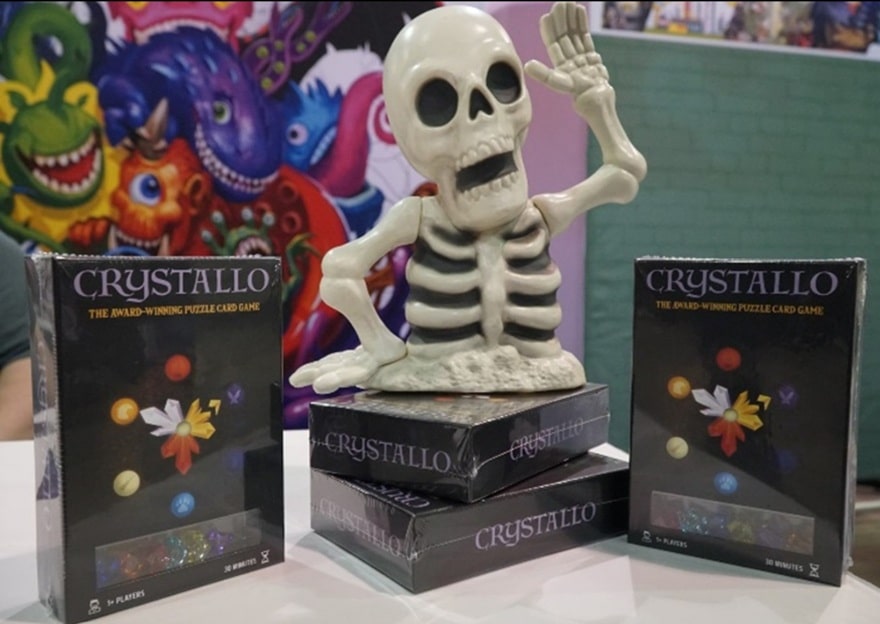 Crystallo Card Game
Crystallo Card Game
Crystallo Card Game: It wouldn’t be a convention without one of us picking up a new game. Though this isn’t “horror” per se, it is still a very cool concept. Plus, the shiny things attracted my attention. Crystallo, designed by Liberty Kifer, is a solo card game where players rescue magical creatures trapped by the Black Dragon’s crystal magic. Combining set collection and tile placement, the game challenges players to form crystal patterns and ultimately trap the dragon. With stunning artwork, tactile acrylic gems, and a 30-minute playtime, Crystallo offers an engaging and replayable experience for solo gamers. Expansions like “Untold Fortune” and “Den of Dragons” add depth and complexity to this enchanting adventure.
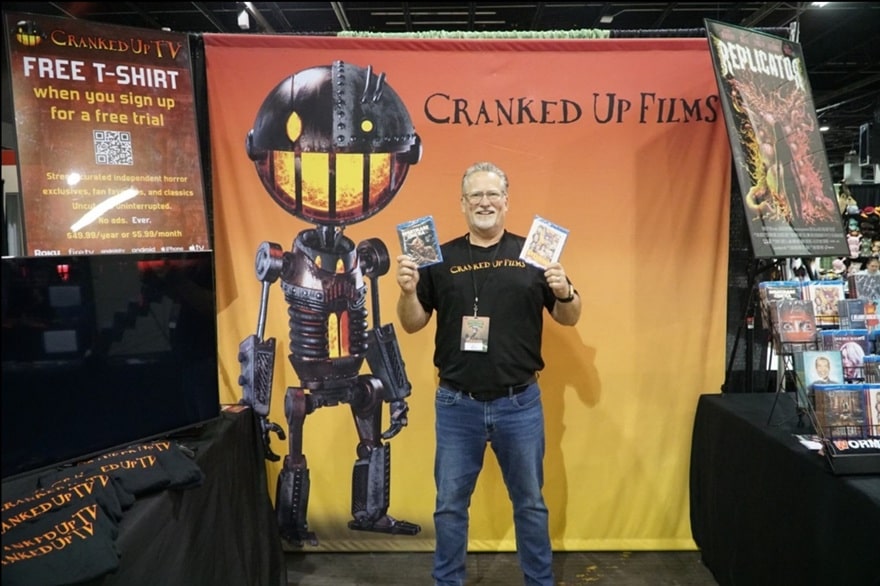 Scott Donley and Cranked Up Films/TV
Scott Donley and Cranked Up Films/TV
Good Deed Entertainment: Scott Donley is the founder and CEO of Good Deed Entertainment (GDE), an independent film studio established in 2012 and headquartered in Ashland, Ohio. Under Donley’s leadership, GDE has built a reputation for producing and distributing character-driven content across various platforms, including film, television, and digital media. The company is perhaps best known for releasing the Academy Award-nominated animated feature Loving Vincent, which tells the story of painter Vincent van Gogh in his signature style. In addition to Loving Vincent, GDE has distributed titles such as Karmalink, Carmen, and Some Freaks, along with the Independent Spirit Award-nominated To Dust and the Annie Award-nominated Charlotte.
Recognizing the growing interest in genre films, Donley launched Cranked Up Films, a division of GDE that focuses on high-concept horror, grounded sci-fi, and speculative fiction. This initiative has led to the production and distribution of films like Nightmare Cinema, a horror anthology featuring segments directed by notable filmmakers such as Mick Garris (Sleepwalkers, Critters 2) and Joe Dante (Gremlins, The Howling). Donley was at Nightmare Weekend promoting his newest venture, Cranked Up TV, the premier destination for ad-free, independent horror, so we now know where our next binge-watch will come from.
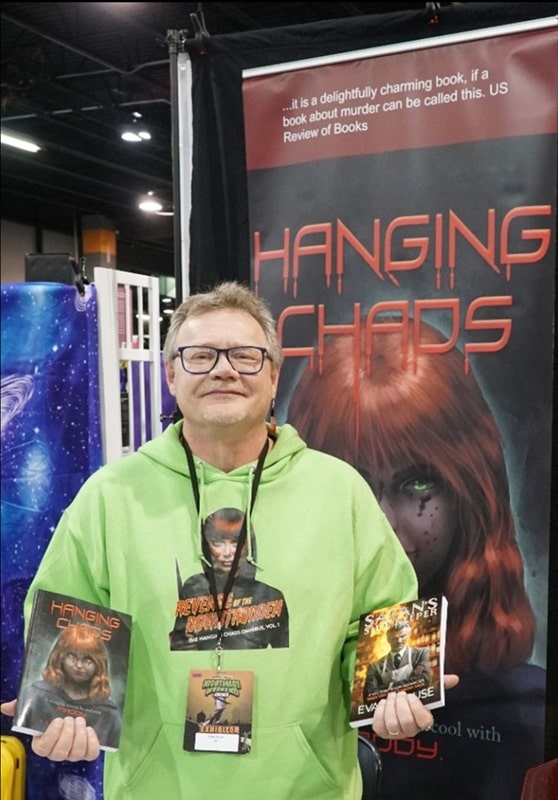 Author Evan Clouse of Hanging Chad Books
Author Evan Clouse of Hanging Chad Books
Hanging Chads Books: Evan Clouse, a former social worker turned author, has made a notable entry into the horror genre with his Hanging Chads series. Launched during what he humorously refers to as his “2/3-life crisis,” Clouse’s writing delves into dark, satirical narratives that blend horror, political commentary, and dark humor. The series follows Maddy Sommers, a vigilante serial killer targeting abusers and oppressors, offering readers a mix of gruesome justice and emotional depth. Clouse’s work has been recognized for its unique approach to horror, combining elements of mystery, love, and social critique.
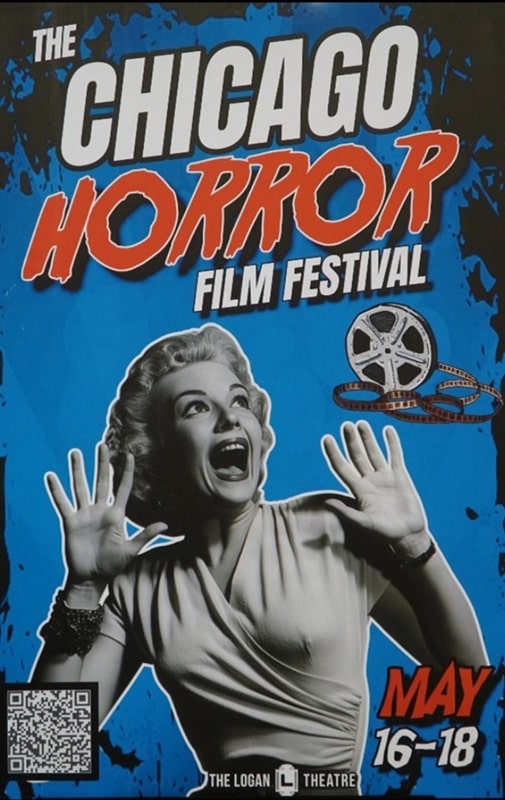 The Chicago Horror Film Festival 2025
The Chicago Horror Film Festival 2025
Last, we had to tell you about two other Midwest events coming soon. The Chicago Horror Film Festival 2025 celebrates its 26th year at the Logan Theater May 16-18. Touted as one of the top 10 horror festivals worldwide, CHFF showcases a curated selection of independent horror films from around the globe, including local and international shorts and features. Tickets start at just $10, with full weekend passes available for $68.99.
The Milwaukee Horror Con returns for its “Fall Frightmare” edition from September 5–7, 2025, at the Four Points by Sheraton Milwaukee Airport Convention Center. As Wisconsin’s only dedicated horror convention, this three-day event promises an immersive experience with horror legends, indie film screenings, themed vendors, cosplay contests, and late-night thrills.
As for GalaxyCon, they are aggressively broadening the reach of Nightmare Weekend to new cities in 2025, including:
- Nightmare Weekend Cleveland: August 29–31, 2025, at the Huntington Convention Center in Cleveland, Ohio.
- Nightmare Weekend Des Moines: September 12–14, 2025, at the Iowa Events Center in Des Moines, Iowa.
- Nightmare Weekend Richmond: October 17–19, 2025, at the Greater Richmond Convention Center in Richmond, Virginia.
- Nightmare Weekend Savannah: November 14–16, 2025, at the Savannah Convention Center in Savannah, Georgia.
A huge thanks to Justin Burkhardt and the Nightmare Weekend promotions team for including us in this first-ever event. We can’t wait for next year.
Spotlight on “The River is Waiting” by Wally Lamb
The River Is Waiting is the propulsive story of a young father who, after an…
The post Spotlight on “The River is Waiting” by Wally Lamb appeared first on LitStack.
On McPig's Radar - Never the Roses
Did I already post about this book before?
And did I already read it because I know the author and she gave me an early digital copy?
Yes! to both these questions.But this book is so good!
Believe me: you want it! It's utterly amazing and beautiful in and out!
Go preorder: I totally did.
 Never the Rosesby Jennifer K. Lambert
Never the Rosesby Jennifer K. LambertUNSTOPPABLE WAR. UNSPEAKABLE SINS. IMPOSSIBLE LOVE.
Genevieve Gornichec’s The Witch’s Heart meets Madeline Miller’s Circe in this epic and deeply emotional romantic fantasy debut by Jennifer K. Lambert. The hardcover edition features beautiful stenciled edges.
The Dread Sorceress Oneira has retired. She’s exhausted from fighting the endless wars of kings and queens, and has long accepted that her death is near. Alone at last but for a few uninvited companions―a near-mythical wolf, a goddess’s avatar, and a feline that embodies magic itself―Oneira realizes that she’s bored. On a whim, or perhaps at the behest of fate, she makes an unlikely trip to the most extensive library in existence: the home of her most powerful rival, the sorcerer Stearanos.
By recklessly stealing a book from him, Oneira inadvertently initiates a forbidden correspondence. Taunting notes and clever retorts reveal a connection neither has found―nor could ever find―in any other.
But Oneira soon learns that Stearanos, bound to a vile king, is tasked with waging war on the queen she once served. A relationship with him is far too dangerous to pursue despite their mutual desire―and yet, Oneira can’t seem to stay away.
A bond with Stearanos could alight the long-extinct flame of life within her… or it could destroy her entirely.
Expected publication July 8, 2025
Life Lessons from David Cronenberg
Let me begin with two assertions, each of which is, in the immortal words of Vincent Vega, “a bold statement.” First: David Cronenberg is one of our greatest directors, and there is nothing he has done that isn’t worth seeing. Second: I am the dumbest, most suicidally foolhardy person you will ever meet. The first statement is arguable, ultimately a matter of opinion, but the second is not, because I can prove it. In fact, I can use the first proposition to establish the validity of the second one.
In case you’ve been living under a rock for the past fifty years, David Cronenberg is the Mutant King of body horror; in stomach-churning, Manson Family date movies like Rabid (an extremely icky form of vampirism), The Brood (nasty little “rage monsters” popping right out of poor Samantha Eggar), Scanners (you want exploding heads — you’ve got exploding heads), and Videodrome (I… I can’t even talk about it, and to this day, neither can James Woods) he set new standards in shockingly gross special effects and in the number of times he forced audience members to barf in their popcorn buckets or make panicked rushes to the restroom.
I thought all these movies were terrific (and not just because of the wild effects — wipe off all the blood and underneath you’ll find a sharp, mordant intelligence with something serious to say), so when Cronenberg’s version of The Fly hit the multiplexes in 1986 it was a must-see for me, and it was with high hopes that I took my lovely wife of barely eighteen months to see it. We were both looking forward to a fun night at the movies. Well…
I had a great time.
Marianne, on the other hand, checked out when Geena Davis gave birth to a bouncing baby maggot (which, to be fair, happened in a dream, so I don’t think it really counts) and spent the last twenty minutes of The Fly hunched over in her seat with her eyes tightly closed, waiting for me to give her the all clear, so she missed John Getz getting his hand dissolved into a bloody stump by fly-spit, Jeff Goldblum’s final insect form emerging while big chunks of his raw red flesh fell off and went splat on the floor, and the bug’s tragic end when his head gets blown to smithereens by a shotgun blast. (She assures me that hearing it all was just as nauseating as seeing it would have been.)
Hey, it was just one rocky evening at the movies; it could have happened to anyone. The main thing is to learn from an experience like that, right?
Fast-forward to 1988. Now the movie creating all the buzz isn’t The Fly — it’s a little something called Dead Ringers. Yeah, I know who directed it, but there are no exploding heads or weird vaginal apertures appearing where they have no business being in this movie. This one is a showcase for serious acting; it’s a character study, you know?
So it was that I persuaded my wife to go to another David Cronenberg movie. (I actually forgot to mention that he was the director. I guess it just slipped my mind.) Not only that, but I also convinced two of our closest friends to come along, women my wife taught school with. This will be great! Diane and Susan are going to love this movie, honey! It’s based on a true story! (Obviously, my motto is, “Be stupid. Be very stupid.”)
I wasn’t lying; Dead Ringers is a great movie, and it is indeed a brilliantly-acted character study. By any measure it’s a darkly seductive, ravishingly shot knockout.
So far, so good. There’s just one problem. Dead Ringers is also, first and foremost, a David Cronenberg movie. And there lies the rub.
Dead Ringers is about identical twin brothers, Elliot and Beverly Mantle, both played by Jeremy Irons. Elliot is smooth, socially ambitious, self-assured and confident (often too much so), while Beverly is introverted, cautious, and much more emotionally vulnerable than his glib twin.
The two characters share a lot of screen time, and one of the best things about the movie is how well Cronenberg employs all the tricks of the trade to make it seem as if Irons really is two different people in the same room together, a task made easier by Irons’ brilliance at subtly differentiating the brothers. (Whenever we see him alone, we instantly know which one he is.)
They are a peculiar pair, these two, and extremely close to each other, even for identical twins. They live together and are in business together, and often one brother seamlessly takes the other’s place when they have to appear at professional functions and the like, and no one is ever the wiser. (Remember The Patty Duke Show?) However, complications ensue when they start sharing the same lover, Claire Niveau, a movie actress played by Geneviève Bujold. The problem is that, for quite a while, Claire doesn’t know that she’s dealing with two separate people, and when she finds out, she’s not happy. Ooops.
The bulk of the movie is taken up with showing how first Beverly and then Elliot start to come apart under the pressure of their extraordinary personal and professional charade, with both brothers eventually becoming delusional drug addicts and descending into outright madness. As you might guess, it doesn’t end well, and things really go downhill when the fraternal craziness starts to manifest itself at the workplace; the whole ghastly situation is made far worse because of the unique nature of the twins’ profession.
What? I didn’t mention what the Mantle brothers do for a living? How careless of me.
No, they’re not architects. They don’t work at the DMV. They’re not certified public accountants or major league baseball players or long-haul truck drivers.
They’re gynecologists.
You begin to appreciate the depth of my folly, don’t you?
I began to think that I had made a mistake during the opening credits, which feature medieval woodcuts of women cross-sectioned to show the children they’re carrying against a background of antique medical instruments that look like they were found lying around Torquemada’s garage; the implications were not comforting.
My growing unease turned to outright panic when an increasingly demented Beverly uses a bulky surgical retractor to conduct an examination on an unfortunate woman; I don’t know if the lady was a method actress, but her winces and grimaces certainly seemed to be coming from someplace real. Halfway through this excruciating scene, I started looking around for an escape route, but I knew it was hopeless; they would drag me down before I made it halfway to the exit.
Then Beverly starts to believe that there’s “something wrong” with “the insides” of all of his patients, that all of the women he’s examining are actually mutants, and he commissions an avant-garde artist to make him a set of “gynecological instruments for working on mutant women.” They look like fruit hanging from a tree on some nightmare alien planet.
The twins operate a fertility clinic (judging from the body of his work — no pun intended — you have to believe that for Cronenberg, birth holds more horror than death), and when Beverly shows up for an operation with these grotesque instruments and actually tries to use them on a patient, he almost kills the woman and the career of the acclaimed Mantle brothers comes to an abrupt and ignominious end.
Despite my sense of impending personal doom, I was powerfully moved by the film’s somber ending, with the outcast brothers lying dead in each other’s arms, as close as they were in their mother’s womb, as close as they had always been during their tragic lives. It almost brought me to tears, in fact.
The tears on the faces of my wife and our friends, however, were of an altogether different kind. They say that it can get to almost fifty below zero in Antarctica. That’s positively balmy compared to the chill I felt walking out of the theater and in the car on the way home, and I was soon to learn that no lamed and bitter ex-cavalry officer can put as much rage and loathing into the word “stirrups” as your average woman can. Some things, I suppose, are just too personal for art.
Well, it was all a long time ago and all those fine ladies eventually forgave me for making them watch a gynecological horror movie, and I did learn a lesson. A year later, the shoe was on the other foot when I sat in the theater with the same group watching Steel Magnolias, and despite my agony, I knew better than to say a single word. I like having all my limbs.
Three or four years ago, I picked up a beautiful Criterion Collection edition of Cronenberg’s 1996 film of J.G. Ballard’s novel, Crash, which I missed when it was in the theater. When I read the book decades ago, my jaw hung open the whole time; it’s the most radically, shockingly transgressive thing I’ve ever read. Of course David Cronenberg made a movie of it. The Blu-ray has been sitting on the shelf since I bought it; I’ve never yet been able to work up the courage to actually watch it. Once seen, some things can never be unseen.
But I do wonder; some evening soon, Marianne is going to ask, “What are we going to watch tonight?”
What do you think? Should I…
Thomas Parker is a native Southern Californian and a lifelong science fiction, fantasy, and mystery fan. When not corrupting the next generation as a fourth grade teacher, he collects Roger Corman movies, Silver Age comic books, Ace doubles, and despairing looks from his wife. His last article for us was Odd Old Indie: Night Tide
7 Author Shoutouts | Authors We Love To Recommend
Here are this week’s 7 Author Shoutouts. Find your favorite author or discover an author…
The post 7 Author Shoutouts | Authors We Love To Recommend appeared first on LitStack.
The Twisted Ones - Book Review
 The Twisted Onesby T. Kingfisher
The Twisted Onesby T. KingfisherWhat is it about:When a young woman clears out her deceased grandmother’s home in rural North Carolina, she finds long-hidden secrets about a strange colony of beings in the woods.
When Mouse’s dad asks her to clean out her dead grandmother's house, she says yes. After all, how bad could it be?
Answer: pretty bad. Grandma was a hoarder, and her house is stuffed with useless rubbish. That would be horrific enough, but there’s more—Mouse stumbles across her step-grandfather’s journal, which at first seems to be filled with nonsensical rants…until Mouse encounters some of the terrifying things he described for herself.
Alone in the woods with her dog, Mouse finds herself face to face with a series of impossible terrors—because sometimes the things that go bump in the night are real, and they’re looking for you. And if she doesn’t face them head on, she might not survive to tell the tale.
What did I think of it:This is yet another really cool horror!
As always Kingfisher managed to creep me out even before anything really scary or creepy happened. I really liked Mouse and her dog, and even though in the first few pages you discover that Mouse is telling the story after the fact, I worried about the two of them.
The building tension and atmosphere is once again so good! It kept me glued to the pages to find out what would happen next. I'm impressed how Kingfisher can write dark atmosphere and manage to have the story be funny at times as well, I must say.
Note: This story is inspired by The White People by Arthur Machen, which I definitely plan to read to see where the stories connect.
All in all another one for my keeper shelves. We'll try one of Kingfisher's more romantic books next.
Why should you read it:It's a humorous and suspenseful horror read

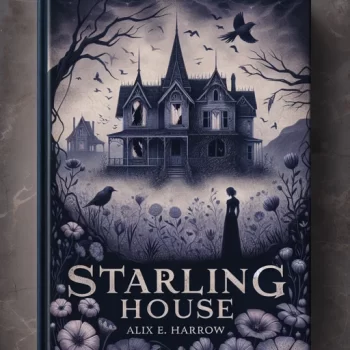


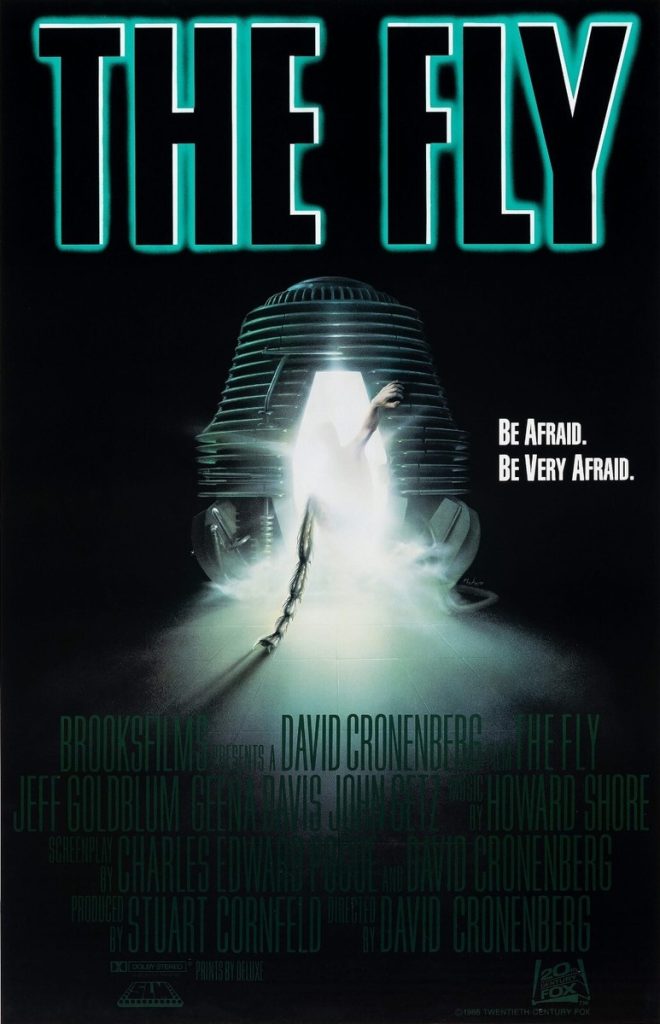
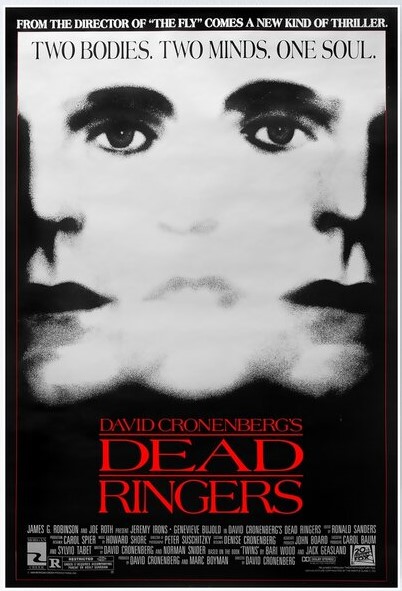
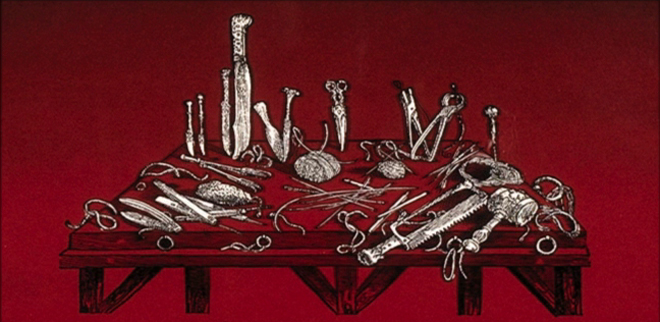
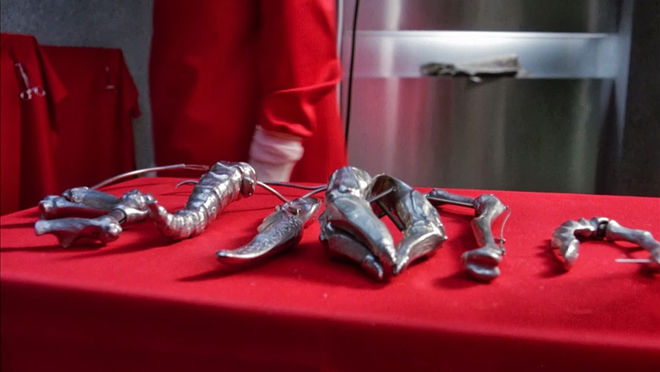
Recent comments